Why Doesn’t My Site Show Up On Google?
There could be a number of reasons your site doesn’t show up on Google. Identifying the cause could mean increasing your revenue by thousands of dollars periodically. Here we’re offering you a systematic approach to isolating the problem and applying the correct solution to win you a spot on the first page of Google.
Find the reason(s) why your website doesn’t show up on Google and you will have identified the strategy to take over the top positions for important keywords to your business.
- Failure to answer search intent
- Your keyword is too difficult
- You’re keyword stuffing
- You haven’t optimized your meta tags
- Too many poor-quality links
- Your website lacks credibility and authority
- Your website has thin content
- Your pages are orphaned
- You’ve received a manual penalty
- Your pages are super slow
- Poor user engagement
- There’s been a Google update
- There’s a Google glitch
- Poor choice of anchor text links
- Too early to rank
#1-Failure to answer search intent
One of the first considerations (for why your site doesn’t show up on Google) is whether your content completely satisfies the user’s intent for the search. Search intent is a crucial issue because it’s the underlying mandate for a search engine to determine the best response to a search query. Your content needs to satisfy exactly what the user is searching for when they type in a specific keyword.
Satisfying search intent is more than just coming up with your version of content you believe users are looking for when they type in a keyword. It also has to do with what search engines see as the best type of content that answers search intent.
It’s true, there’s a possibility you may be in sync with what users are looking for, but if your pages aren’t ranking you need to look to the top ranking sites to see how they’re satisfying intent.
First clues are in the titles and headlines you see in the SERP. Do the titles indicate a predominant style of content that’s appearing as top results? How many are ultimate guides? How many are “Best-of” lists that provide a user with options?
Pinpoint the way the top ranking pages are satisfying intent and make sure your content covers every aspect and more in the topics that are covered.
Publish content that is 10 times better than what already exists. The skyscraper method has proven to be one of the most effective strategies for outranking and outperforming pages that compete for similar keywords.
#2-Your keyword is too difficult
Many business owners make the mistake of attempting to rank for a keyword without checking the level of difficulty of the keyword. If your website is in its early stages of development, there may be search terms that are not realistic and should be avoided for less competitive options.
Assess the average domain authority
The difficulty of a keyword can be assessed by reviewing the average domain authority held by the competing websites. Domain authority is a form of measuring the ranking ability a domain has that is based on the quantity and quality of links it has accumulated.
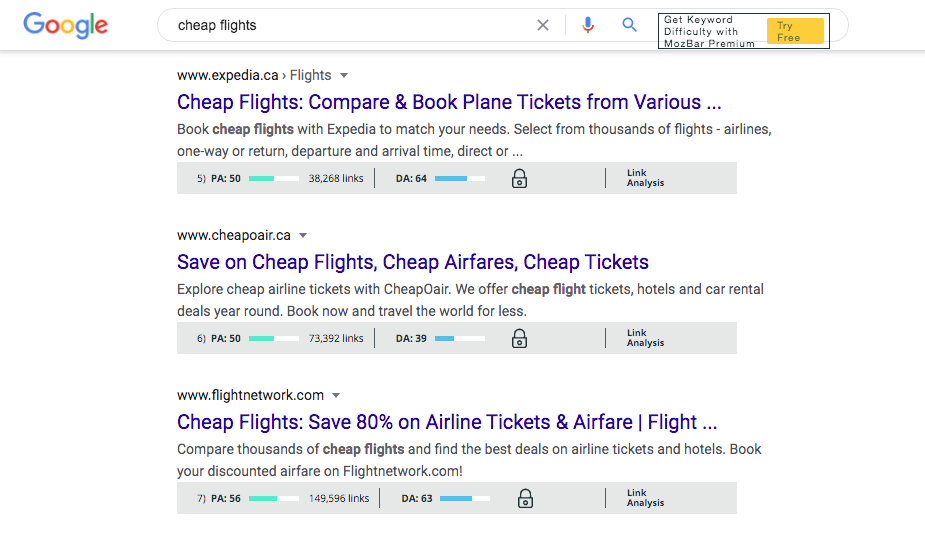
Suppose you were attempting to rank for the search term cheap flights. Your website would be competing with giant authority domains like Expedia and The Flight Network. These websites have been around for years accumulating thousands of backlinks and are considered trusted brands in the industry.
It wouldn’t be realistic to target a keyword that is so competitive without having some sort of competitive advantage that puts you on an even playing field.
Get an idea of the average backlinks pointing to the ranking pages
Search engines don’t rank websites, they rank pages. When you assess the first page of search results, take into account the number of backlinks pointing to each of the ranking pages.
A common trend is that the more domain authority a website has, the fewer links they need to rank its pages. You can use backlinks to increase the page authority of your site in order to compete with domains with greater authority (see image above where Cheapo air has double the backlinks but equal page authority as its competition).
If a website has a similar domain authority to yours, you may be able to beat them by acquiring better backlinks.
You can use Moz to find the backlinks that any given website has pointing to their pages. Make a judgement call on whether it’s realistic to attain the same or more quality links to your page.
Make sure your content meets and exceeds search intent
Even with equal links and domain authority, your content needs to measure up to what’s out there. Make sure your page is able to compete with the competition in the depth of coverage, UX and overall quality.
#3-You’re keyword stuffing
If you repeat a keyword in excess throughout the body of content, it may the reason why your (site doesn’t show up on Google. This is called keyword stuffing and will land you an algorithmic penalty see the Panda update) that prevents your website from ranking highly.
Check to see how many times your keyword is repeated within the body tags of your page (doesn’t include title or URL). Keep your keyword ratio below 2% to avoid over-optimization. If you’ve optimized your meta tags, an exact match keyword need only be sprinkled a few times naturally throughout your content.
#4-You haven’t optimized your meta tags
Place your keyword in the most important parts of the page that search engines use to determine the most important keywords for your page.
Include your target keyword in the title, URL a few times within the body of text as well as in the alt tags of any images on your page.
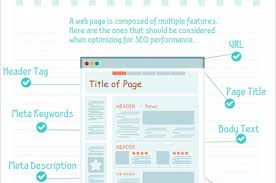
Use keyword variations in your subtitles and throughout your content to provide more contextual relevance.
#5-There are too many poor quality links
If you have too many poor quality links search engines may devalue the authority of your domain. A low quality link are backlinks that:
- Have no strong relationship to your content.
- Are considered easy to get, such as directory links, profile links, links from forums.
- Have no backlinks itself.
- Have low domain authority.
- Have been penalized
The Penguin update changed how Google assesses link quality and could be the reason why your site doesn’t show up on Google.
#6-Your website lacks credibility and authority
One of the major reasons to acquire backlinks is to build the authority and credibility of your content. Backlinks are a major indication of the popularity of your website.
A backlink represents one website vouching for the content, products or services of another. The accumulation of backlinks therefore builds credibility in terms of many instances of websites vouching for your content.
If your website doesn’t have enough quality referring domains, your credibility for publishing trustworthy content is considered low since there’s no real proof or evidence to say otherwise.
Editorial links from high authority websites that are in the same field of expertise are among the best types of links you can receive. You can build credibility much quicker with much fewer links from sites like these than from low authority websites.
#7-Your website has thin content
Websites that have very little content on their site tend to rank poorly. Without content, it’s hard to get pages to surface at the top of search results for keywords.
Search engines categorize and compare websites to one another in the same niche.
Compare a website with 520 pages of content vs. your website with 3 blog posts. Which one would be more capable of satisfying search intent? Which website appears more trustworthy as an expert in its field?
It’s publicly known that Google reviews specific websites manually to score them on the E.A.T. principles. Expertise, Authority and Trust play an important role in being able to present the top results of a query to users.
There’s some speculation that EAT is baked into the algorithm to an extent already although no one can say for sure. What we do know from documented evidence is that websites that have libraries of relevant content will more often than not outrank websites with thin content.
#8-Your pages are orphaned
Search engines find and index new pages that are submitted in a sitemap or when they crawl websites and discover new pages by following links. If there are no inbound links (internal or external) pointing to your page and it’s not in the sitemap, your page is considered to be orphaned.
Every page on a site should be connected in some way. Ideally there should be a way to get to any page on your website within four clicks. Sitebulb provides a visual way to see how your website is linked through a directory radial such as this:

In order to make sure your pages are indexed, they should be included in a fresh sitemap and submitted to Google. Use Google search console to submit new sitemaps as a way of telling Google to index new pages.
It’s best practice to link to new pages you publish in order to connect related content, spread link equity and improve your website’s internal click-through rate. This also allows your pages to be found and indexed faster than waiting for Google to process your sitemap.
If you already have links pointing to those pages, make sure they aren’t marked as nofollow. The nofollow attribute will tell search engines to ignore the link and withhold any transfer in authority that a followed link would give that page.
#9-You’ve received a manual penalty
There are two types of penalties that are commonly referred to; Manual actions and algorithmic penalties. The second, algorithmic penalties are really not penalties per se and are actually just filters baked into the algorithm that can be reversed when you’ve isolated the cause. Manual actions, however, are more severe and usually result in your website being removed from the index.

You can check Google search console specifically to see if any manual actions have been given to your domain. If you received one, you will have specific instructions from Google on why you got it and how to correct the issue.
#10-Your pages are super slow
It’s been years already since Google publicly announced that page speed is an official ranking factor that can affect the search visibility of your website. If your pages are taking too long to load, no one will want to stay on your pages and as a result Google drops your website in ranking.
Rankbrain, Google’s AI that facilitates ranking, measures this user engagement statistic as part of the overall placement of your website. If most of the people landing on your page are backing off of your site immediately, your website is demonstrating signs of a poor user experience and low engagement. That signals Rankbrain to boot your site down in ranking.
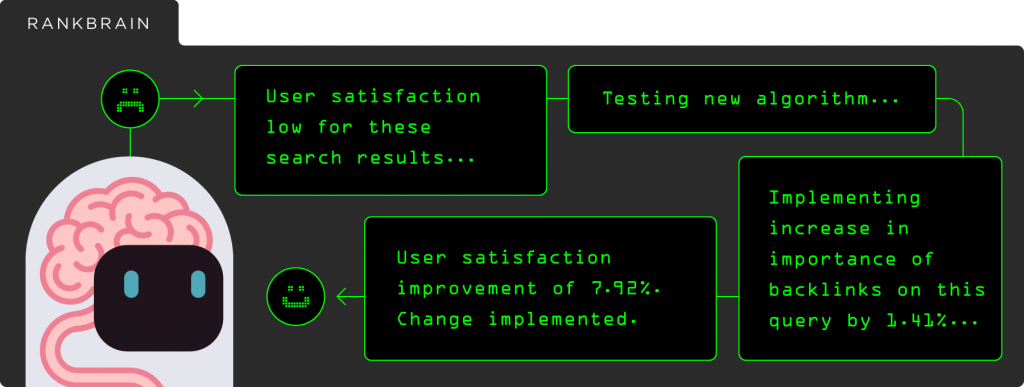
You can test your page speed using GTMetrix.com to see if your page clocks in under the recommended time of 2 seconds to the first contentful paint.
Almost every page speed tool generates a report on the elements that are blocking your site from loading quickly. Improving your page speed becomes a matter of being able to execute the corrections that are listed in your report.
#11-Poor user engagement
User engagement is a growing factor in the ranking algorithm. Your site is always being compared to other websites (especially if it’s on the first page of results) to see how users are reacting to your content. If the user engagement on your website underperforms in comparison to the competition, your site will continue to slide down and off of the first page of search results.
Poor user engagement is indicated by the bounce rate, dwell time, pages visited per session and the expected click-through rate vs. actual click-through rate.
You can improve all user engagement stats by adding internal links, increasing page speed, adding images and features that would entice visitors deeper into your website.
Adding a video is a proven way to increase the length of time that visitors spend on your website.
Improving your headlines, meta-descriptions and adding structured data markup for rich results are also a way to improve the number of clicks that users are making to your site from the SERP. By making your search listing more attractive your page receives more attention, resulting in more clicks to your site.
Improving the overall user experience will increase the user engagement statistics your website generates and drive up your keyword ranking.
#12-There’s been a Google update
In the past, Google updates have turned the entire internet upside down. If Google implements a major update that changes how they rank websites, you could be looking at an algorithmic filter keeping you off of the first page of search results.
Updates like Panda represented major changes to how Google was assessing on-page content. Any website that was caught keyword stuffing was instantly penalized algorithmically and lost search visibility from its current rank.
Penguin changed how Google viewed high quality backlinks vs. low quality backlinks. Entire businesses were lost overnight when Penguin first hit the internet.
Avoid any drastic changes to your websites ranking by following Google’s best practice guidelines. If you’re not engaged in any blackhat tactics that violate these rules, you won’t be at risk to massive changes when an update kicks in.
#13-There’s a glitch in the matrix (Google of course!)
It’s been reported that Google updates the algorithm multiple times on a daily basis. Google is constantly adjusting the way its search engine is running. Just because they have a stranglehold on the search engine market doesn’t make them impervious to mistakes or glitches.
There are many moments throughout the year where rankings get completely shuffled for a period of time. In most instances the shift in rankings don’t last more than a day or two before returning to normal.
For more clarity on what’s happening in terms of changes in ranking, you can check out Mozcast. The tool tracks a large cross section of websites and bases its score on their fluctuation in rank. The measurement ranges from 1-100, where 100 is extremely volatile and 1 is absolutely no changes.
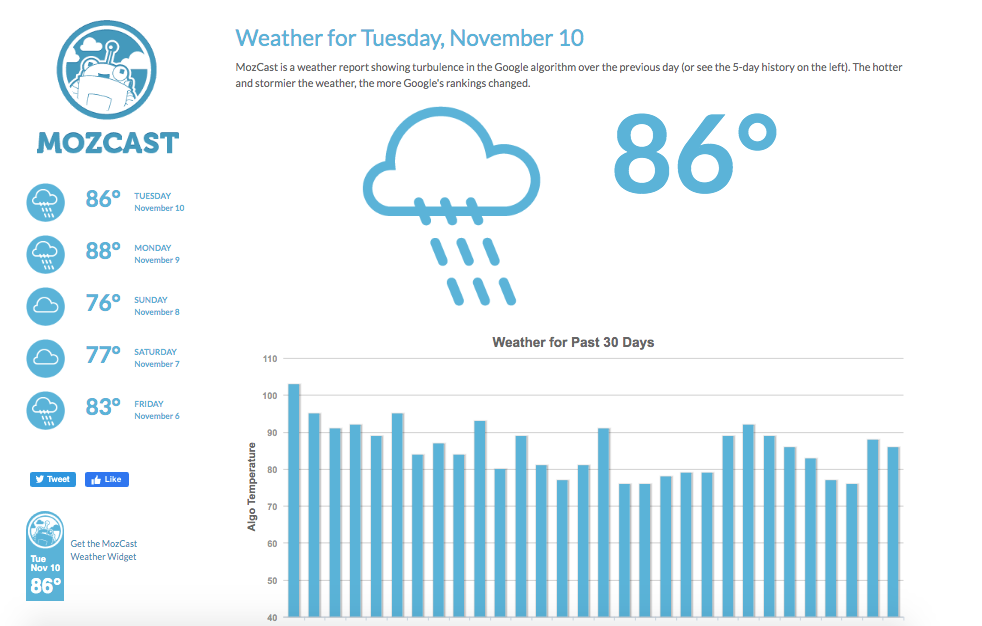
Nothing can prevent glitches from happening; you just need to ride them out. Eventually order is restored so before you go sounding alarms, check out the Mozcast to see if the entire internet is getting a shakedown.
#14-Poor choice of anchor text links
The anchor text you use when pointing links to your website can have a large impact on your search visibility and be a reason why your site doesn’t show up on Google. Too much of one type of anchor text can lead to over-optimization. Not enough descriptive anchor text and you come up short on properly optimizing your page.
Keep in mind that Google wants to see links build naturally. The Panda update is essentially a filter baked into the algorithm that corrects the excessive use of anchor text links with a drop in search visibility.
Although internal links may not have as much impact as external links, you should still be aware of the anchor text you use to link internal pages. Vary your anchor text links and avoid using too much of any one keyword.
For more guidance on how to structure your anchor text link ratios, it’s always a good idea to see how the top-ranking pages have done it. Learn how to use anchor text links to enhance the ranking power your pages have rather than hinder them.
#15-You’re being too impatient
Just because you publish an article and stick a link on it doesn’t mean it will blaze its way to the top of the search results. Give your links and content a little time to be crawled, indexed and climb its way up in ranking.
A study was done on the number of pages that rank on the first page and the results showed that it’s difficult for pages to rank on the first page in less than a year.
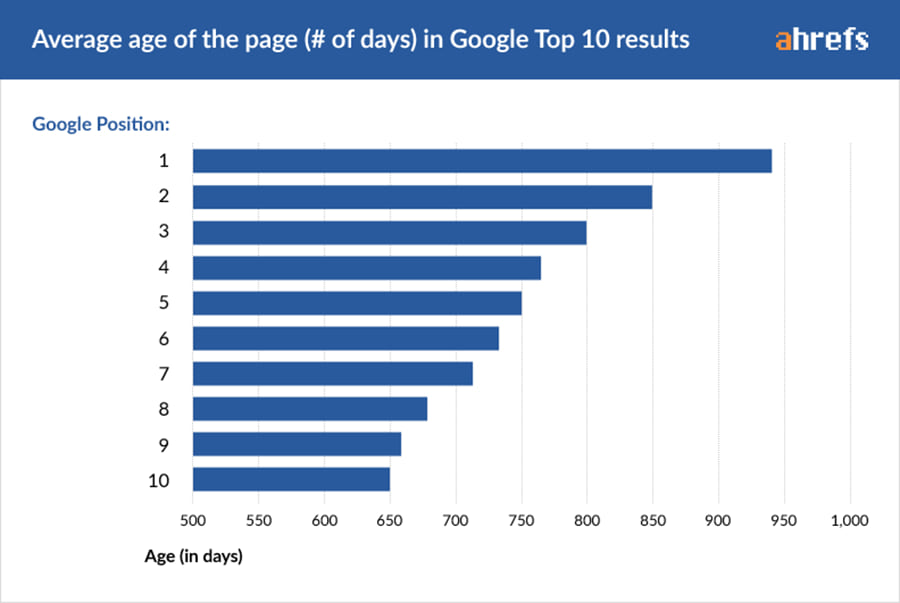
Of course, there’s an exception to every rule. Low competition keywords can rank in as little as a few weeks if you have all the right pieces aligned.
The point is to have realistic expectations for where you’re currently ranking and where you should be ranking in the search results. If you’re not there yet, check yourself before you wreck yourself. You might not have given your work enough time to blossom, which is why your site doesn’t show up on Google.
Related reading: Benefits of Online Marketing For Businesses
How To Use Anchor Text Links
If you’ve ever attempted building links to your website you may have already come across one of the textbook conundrums regarding how to use anchor text. If you want to make sure that you don’t over or under optimize pages you’re trying to rank organically, continue reading to learn how to find the perfect blend of anchor text for your website.

What is anchor text?
Anchor text is the words that link one page to another. In most cases, you can see anchor text because links are normally a different font, underlines, or bolded. This isn’t always the case, but the fact is that if it’s text that links to another site, that text is considered anchor text.
The html for an anchor text link looks like this:
<a href=”https://digitalducats.com” <Digital Ducats Inc.></a>
This links the company name to the homepage like this: Digital Ducats Inc.
Google and every major search engine use anchor text as a way of assigning contextual meaning to a page. By using descriptive words to link to a website, you enhance the optimization of that page for those keywords. Using your keyword as anchor text is called an exact match anchor text link.
In fact, prior to 2012, that’s exactly what people were doing to push websites to the number one position on the first page of search results.
Since Google used anchor text links as a way of establishing the relevance a page had to a search query, people would build a massive amount of exact match anchor text links to their page.
The more links you had with your keyword, the higher you ranked.
Enter the Penguin
Of course, Google did away with this type of link manipulation in a series of updates. The most infamous of updates was the Penguin update in which they targeted websites that were over-optimized with anchor text links.
The Penguin update issued an algorithmic penalty for link manipulation. If your site was clearly attempting to manipulate your ranking through link building, your pages (and entire website in some cases) was banished a number of pages back in the search results.
If the link manipulation was severe enough, your website was removed from Google’s index altogether.
Fast-forward to today’s link building environment
Since the initial Penguin update, there’s been a series of anchor text ratio theories and practices that have worked for a period of time only to fall by the wayside.
The truth is that all major search engines have been continuously evolving and advancing their ability for detecting link manipulation. There are no set standards to abide by other than trying to make your link-building look as natural as possible.
In order to get the best guidance on how to structure your link building strategy, you need to see what the top ranking websites are doing to rank for your keyword.
Every keyword in every niche can be different, which makes analyzing the top-performing pages your first step to establishing successful anchor text ratios.
Establish the average number of optimized anchor text links
This procedure is simple and effective for establishing the standard. You’ll need to use software to get a list of the backlinks of the top websites. Ahrefs is the best for this job as they have the freshest results and seem to pick up the most backlinks compared to other tools.
Export the backlink reports of the top five competitors for the keyword in question. You can toggle the reports any way you please but it would be beneficial to export the reports that summarize the anchors from each page.
Make sure you’ve selected to report the anchors from one domain only in order to avoid counting site-wide links.
You’ll want to count every anchor that has your keyword or a partial match within the text. Get the number of anchors that include your keyword for each of the top five websites, add them together and divide them by five.
You now have the target number of anchor text links that will include your keyword in your link building efforts.
Exclusions and considerations
There can potentially be websites that do not provide a good comparative analysis. Make sure you’re taking into consideration the number of links, the size of the website, the type of website and any other factors that would make your result less accurate.
For example, if there’s a high authority website that only has a few links and every other site on the page has hundreds, ignore this site and use the next one down on the SERP. These types of websites will throw the accuracy of your average way off.
If a website is a directory or some other type of site that doesn’t match with your control group, exclude it from your average.
Top practices to include in your anchor text link building strategy
- Make your link building natural
- Never use the same anchor text repeatedly
- Avoid over-optimization
Make your link building natural
Build links that make sense to the reader. By forcing the keyword into your text you raise red flags regarding link manipulation.
Local keywords are commonly used improperly when linking to a local website. Consider this sentence:
PaintWorld is your premiere paint shop Boston.
As opposed to:
PaintWorld is your premiere paint shop in Boston.
Google knows the money keywords that people are using to find websites and it also recognizes natural speech patterns. The entire algorithm is now built around search intent so it isn’t necessary to force the exact match keyword into your text when it doesn’t fit naturally.
Never use the same anchor text repeatedly
Vary your anchor text and avoid repeating the exact keyword in excess. Consider the following keywords:
Boston paint shop
Paint shop Boston
Paint shop in Boston
Paint store in Boston
Paint supply store Boston
They all have the same intent behind the search. Vary the anchor text to keep your links looking as natural as possible. This also goes for naked URL links to your site.
Everyone is wired differently and therefore will link to websites differently. Change the way you’re linking to your site each time when using a naked URL link.
For example, consider the following URLs to the same domain:
- Paintworld.com
- www.paintworld.com
- https://paintworld.com
- https://www.paintworld.com
- https://www.paintworld.com/
- http://paintworld.com
These are just a few variations. Each of the above URLs can be mixed and matched to create dozens of versions of the same link. What are the chances that 100 people will link to your URL exactly the same way?
It would be a miracle if half of the people that linked to your site using the exact same naked URL link. Vary your anchor text in every type of link in order to maintain the most natural looking link profile.
Avoid over-optimization
It’s necessary to use exact match anchor text in your link building strategy but it’s better to err on the side of caution. If you have an exact match domain, this gives you less flexibility in the links you send to your website.
For example, if your keyword is bespoke suits Toronto, consider the following domains:
- Customtailors.ca
- Bespoketailor.ca
- Bespokesuitstoronto.ca
The first domain gives you the most flexibility with the anchor text links you send to the site. It doesn’t contain any part of the keyword you’re trying to optimize for allowing you to link using exact match anchor text.
The second domain has a partial keyword within the domain. This means you’ll need to see how the site reacts with the types of links you send.
The third domain gives you the least flexibility and presents a delicate situation in the type of links you send. The domain is already highly optimized meaning that it won’t take much to draw an over-optimization penalty.
Exact match domains will typically do better by linking the naked URL since they already contain the keyword within the domain.
The keywords already included on-page will affect the amount of keyword-optimized anchor text links you send to your website.
Use a partial keyword in your anchor text
There are no absolutes when it comes to optimizing your page. No one can say for sure what the factors are that affect how Google ranks your page. Consider the option of linking to your page using partial keywords.
For example, if your website is a local business, you can link using the city or the service on its own for your anchor text. Use this tactic when applying exact match anchor text is having no effect on the position of your page.
Use un-optimized anchor text
It’s always wise to use un-optimized anchor text to mix up the types of links that are pointing to your website. Use text like click here or visit the website or any type of text that doesn’t have your keyword. It makes sense that links would naturally build this way so include them in your strategy.
Conclusion
The most important part of using anchor text is that you establish a guideline based on the pages that are currently ranking for your keyword. Be willing to adjust your strategy based on the reaction your website has to new backlinks.
There are no absolutes when it comes to optimizing your anchor text. Find the balance through analysis and adapting to the unique optimization factors your website possesses.
As a major part of your link building strategy, it’s important to get this aspect right. It can make or break the success you have in ranking highly for your target keyword.
Related reading: Why Doesn’t My SIte Show Up On Google?
The Advantages Of An Internal Link Building Strategy
Every website needs a link building strategy. Most people who are familiar with link building will immediately think of external links and the many link building tactics that have become the norm for acquiring backlinks. The truth is you need an internal link building strategy in order to capitalize on the many benefits it provides to your website.
What are internal links?
An internal link is the hypertext link between two pages located on the same domain. They provide contextual meaning through descriptive anchor text and lead visitors to related content.
Internal links provide link equity by passing on page authority. Like any other link, topical relevance is a big component for providing a quality internal link.
For example, the relationship between a web page about dog training that links to a page on dog tricks is obvious. They are topically relevant and therefore the traffic that travels between pages is likely to be engaged with the content on both sides of the link.
Good things happen when you have a strong internal link structure. Increase the optimization of your pages by linking pages that compliment each other with relevant topics.
Enhance your pages optimization
The link target becomes more optimized through descriptive anchor text. It’s recommended to avoid exact match anchor text in excess and to avoid using the same anchor text to the same page.
Over-optimization is a risk you can avoid by using long-tail descriptive anchor text.
The linking page also enhances its optimization by showing a direct relationship to related content. Search engines don’t rank based on keywords anymore, but based on keyword topics.
When your page demonstrates stronger depth in the keyword topic you’re covering, you gain more credibility for covering a keyword topic in breadth.
Google discovers new pages by following links
When a search engine crawls your website, they find and index new pages by following links. You can index new pages on your site much faster by providing a link to its page from existing content.
Without linking to your content, the only other way for a search engine to find the page is to have it listed in your sitemap.
When a page has no internal or external links and is not listed on the sitemap it’s considered an orphaned page since it has no way of being discovered.
For websites with a high number of pages, an internal link building becomes a necessary part of getting your pages indexed since there is a limit to the crawl budgets Google assigns to your website.
Increases user engagement statistics
As you may or may not know, the user engagement statistics your website generates are used as a way of determining whether users are enjoying your site and whether it answers the user’s intent.
Increased Dwell time
For instance, the time that the average visitor spends on your website can tell search engines whether users are engaging with your content. Google uses Rankbrain specifically for this aspect.
If your site has an average time of 5 minutes while the competing websites are at one minute, your website is going to move up in rank. It becomes obvious that users are finding your content useful and worthwhile checking out.
Improve the dwell time of your website by linking to as many related articles and pages within your content. It needs to be related to each other of course so that people can explore other related topics that will capture their attention.
Improved click-through rate
The internal click-through rate on your site is also a user engagement statistic. The average number of pages visited per session is the name of the official column you can look in to see this metric on Google Analytics. If your site demonstrates a high value in this area, it means visitors are clicking through to additional content because they’re interested in what they’re finding.
Decreased bounce rate
The bounce rate is the percentage of people that immediately back out of your page after landing on it. A higher bounce rate means that fewer people stay on your site and click through to internal pages. The lower your bounce rate the more visitors are staying on your page and engaging with your content.
Although high bounce rates can indicate that visitors are either not liking your content, they can also result from a lack of internal links that leave a user with no way to move further into your website. By adding internal links you provide another path to access more pages within your website. The addition of internal links therefore reduces the bounce rate.
Internal links can generate more conversions
A lot of good things happen when you’ve implemented an effective internal link building strategy properly. The increased click-through rate and increased dwell time contribute to getting more content in front of your visitors. This leads to more confidence in your brand and ultimately more conversions.
The links you place in your content should lead visitors towards a conversion goal you’ve set for your website. Set up your goals in analytics to track how well your website is accomplishing this task.
Whether your goal is to get a phone call, contact form, sign up for a newsletter or purchase your product, you can set it up in Analytics.
Use internal links to lead visitors to high converting pages and contact forms throughout your content.
Internal links build authority in a keyword topic
Use your internal links to create topic clusters. A topic cluster is composed of a pillar page, which is the main keyword topic. The pillar page will cover a keyword topic in breadth but not depth. Rather than go into detail it will link to smaller articles that have a narrow focus on a smaller subtopic but dive into greater detail.
The smaller articles should link to each other where it’s appropriate, and all of them will link to the pillar page. The pillar page links to the smaller articles, which creates the topic cluster model.
Technically, the pillar page accumulates authority because of the number of links pointing to it from the cluster content. This establishes the keyword topic as a pillar of your website which helps your website show up for more keyword related searches.
Use internal links to increase the user experience
At the root of all ranking factors lies user experience. Implement an internal link building strategy to create more entry points to your pages and allow users to explore more related topics that interest them.
Link to topically relevant pages to create topic clusters while improving the user experience. The additional effort you provide in establishing our website in your major keyword topic will pay off in dividends.
User engagement is a powerful ally to have in your corner, so keep your users happy by offering links to more content they’ll love and you’re guaranteed to enjoy more success in the search results.
Why Web Design & SEO Are Inseparable
Web design and SEO are inseparable. Without a website, you can’t have SEO and what’s the point of having a website, if no one can find it? Incorporating SEO at the earliest stages of your website’s development is a smart decision that will save you an enormous amount of time, money and resources.
Search engine optimization involves a lot of moving parts but when you isolate the fundamentals, you can incorporate these aspects into your website design from square one. This article will detail the necessary design elements that impact how search engines view and rank your website.
Choosing your domain
Choosing your domain may sound like an easy task, but there are specific features that you should take into consideration. To give your website the most competitive advantage you should consider optimizing your selection as well as choose the correct domain extension and protocol.
Incorporate a keyword
If the opportunity presents itself, choose a descriptive domain that summarizes your brand and the products and services you offer. When you’re competing against a bunch of other websites for the same keywords, the added edge in having a keyword or two within your domain results in increased search visibility.
This isn’t absolutely necessary, as you can optimize to compete without it, but it provides a competitive advantage in local SEO. If your website represents a specific location, you can get the upper hand in appearing for localized search results. Google tends to display keyword-optimized businesses in the local pack.
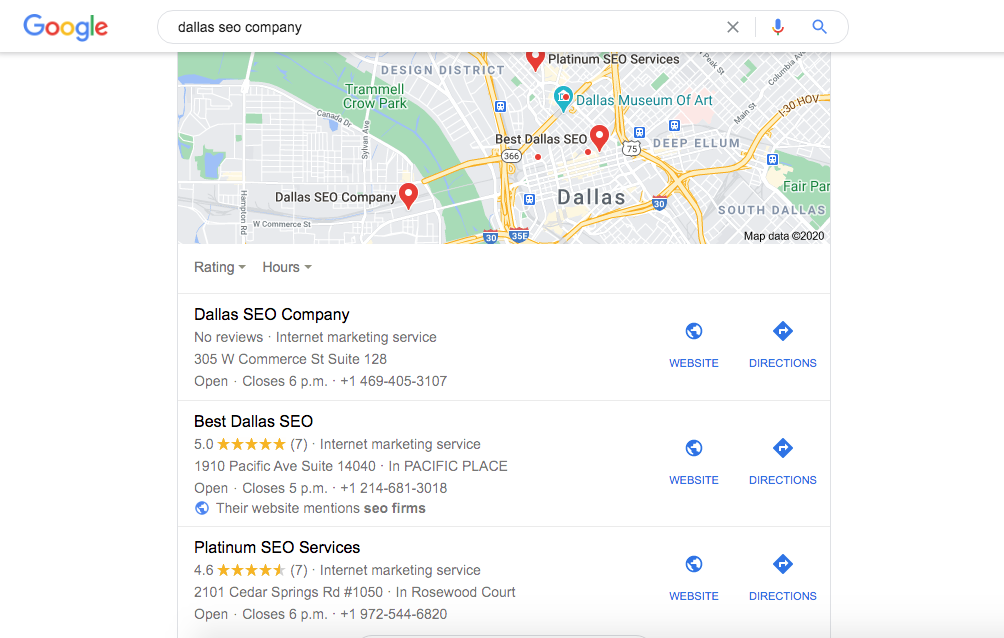
You can see examples like this in every niche. With a keyword within your business name and URL you’re company is optimized to appear in the Local Finder for keyword related searches.
Domain extension
The second part of your domain selection is choosing the domain that you want to represent your business. In Canada, local businesses use .ca’s to rank highly in localized search results.
Of course, .com’s are the best option for the US and work well for global search results. They also work well in Canada but when you want to focus on appearing for search results within your country choose the appropriate extension for the best results.
Domain protocol
Choose the protocol that every version of your domain will redirect to so there’s only one domain with canonical URLs.
For example, consider the following options for domain protocols that can be entered for one website:
- example.ca
- http://example.ca
- www.example.ca
- https://www.example.ca
- http://www.example.ca
All of these versions of your URL should redirect to one URL only. This will avoid confusion and any potential duplicate content issues.
Choosing a hosting company
The company you choose for hosting should be reliable and offer your site fast server response time. The time it takes for your pages to load will directly affect user engagement metrics, which we’ll get into later in this article regarding page speed.
Choose a hosting company with a data centre that’s in your country or close to your location. It makes no sense to choose a company in India when all of your traffic is originating in Canada.
Keyword research
This becomes a crucial aspect of your website design because you need to incorporate the most important search terms your clients are using into your site architecture, URL structure and content strategy.
By establishing the search terms that will drive the most traffic to your business you can embed these terms into the very fabric of your website. This affects how you silo your website with descriptive URLs for categories, subcategories, products and services and how you plan your content.
The keywords that represent your business should be determined in the planning phase of building your website. This ensures that your website takes the right direction from the very start by targeting the terms that will drive the most traffic with visitors that convert into clients.
Site architecture and URL structure
The way your website is organized should resemble that of a filing cabinet. Your website is the filing cabinet, the drawers are the categories, the folders are the subcategories and the files are the pages.
Filing cabinet
–Drawers
—-Folders
——–Files
For example, Woo commerce template for websites that sell retail products looks like the following:
Homepage
–Categories
—-Subcategories
——–Products
Your site architecture needs to make sense for both search engines and users. This level of organization makes it easy to assign a hierarchy of pages and assign value to the most important aspects of your business.
URL structure
The URL structure should follow suit with your site architecture with descriptive terms that indicate where a user is on your website. Each level of depth that a user goes into should be divided by a subfolder so the can get to where they’re going within four clicks as well as find their way back to where they came from.
Example.com
Example.com/services/
Example.com/services/SEO/
Example.com/services/SEO/link-building/
Using descriptive words in your URL structure makes for a more user-friendly and search engine-friendly website. Depending on the CMS you’re using your URLs may be automatically generated which can result in the following:
Example.com/rtsh%7j
Example.com/12-04-2020/lghtn345
This type of structure has no order and no meaning to users or search engines. Plan the URLs before building your website to avoid sloppy and nonsensical URLs.
Navigation
The navigation on your website needs to be clear, concise and take a user to all of the most important parts of your website within a few clicks. Your homepage is where most users will land so it’s necessary to have the means to get to all the important places quickly and provide a way for users to find those places without thinking.

Think of creating your website’s navigation as if you were putting up signposts. You want traffic to be guided to their destination with the least resistance. If your website navigation forces people to think or sends them the wrong way, it makes for a poor user experience and you will lose visitors.
Mobile usability
We live in a mobile-first era which makes mobile design the most important version of your website. Although this varies in importance with industry, Google indexes the mobile version of your website first. Your website is reviewed and assessed based on the mobile version since more than 50% of users search for information on a mobile device.
Responsive vs. mobile-friendly
Websites have been made responsive for some time, however just because a site is responsive doesn’t mean that translates into being mobile-friendly. There are other elements to being mobile-friendly that need to be taken into account.
A mobile-friendly site is a site that’s easy to use on a mobile device and provides a good user experience. It’s possible to have a responsive website without it being mobile-friendly. It’s important to address these issues, which can be identified using Google’s mobile-friendly test.
Page speed
The speed at which your pages load plays an important role in how your site is viewed by search engines and users. Most people are too impatient to wait for a page to load for more than a few seconds. In fact, Google states that after 3 seconds of load time, visitors are five times more likely to leave your web page.
From an SEO perspective, this reduces user engagement statistics. The overall dwell time is reduced, the bounce rate increases and the click-through rate is lowered. The effect of slow page speed has a negative impact on your search engine results.
This mainly stems from the fact that what’s good for a user is also good for search engines. If people are leaving your site before the pages even load, it signifies a poor user experience. Your site would seem unpopular and therefore would get pushed down in the search results.
Mobile friendly attributes
Make your site mobile friendly to improve your websites SEO. If your website is not easy to use, you’re going to lose visitors.
An example of a poor usability issue is when the text is too small. This causes users to “pinch” the screen to read the text, which also leads to scrolling side to side. Making changes to the mobile attributes of your website will affect the way users view your site and whether they continue to use it, or seek out an easier website to use.
Simple mobile attributes like button functionality is a major issue in the usability of your website. If buttons are too close together and users are clicking on the wrong ones, it can be frustrating and lead to the loss of visitors.
Test the mobile-friendliness of your site to determine what changes need to be made. Not only will you improve your website for users, but the changes will affect how your site is displayed in the search results.
Marketing funnel
A major aspect to how you structure your content is how you address users at each stage of the buyer journey. The keywords you plan on using to drive traffic should be represented by content that creates awareness, consideration and influences decisions.
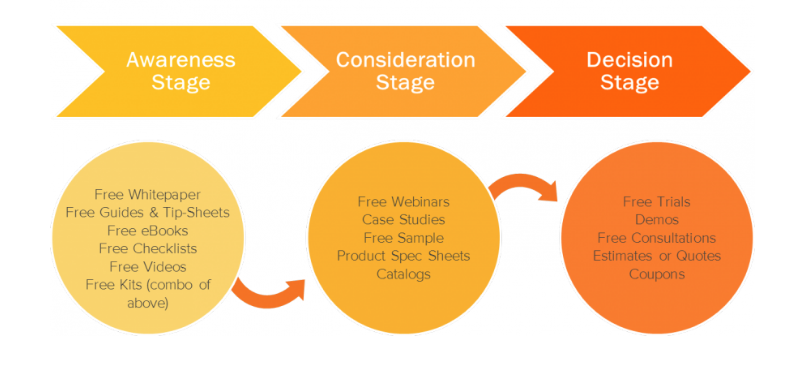
Content that’s published at the awareness stage includes ultimate guides, top ten lists, etc. Content that’s published at the consideration stage includes case studies, original research, etc. Content at the decision stage includes product pages, service pages, free trials and consultations.
A visitor that lands on your website should be guided through all three stages of the buyer journey. This planning takes place in your keyword research.
Publish the bottom of the funnel content at the beginning stages and work your way up. This way you can facilitate those that are in the later stages of the buyer journey to make a purchase. You can then expand your reach as your site develops more content.
On-page optimization
Here’s where a lot of the magic happens for a website’s search visibility. The communication you have between your website and the search engines can make the difference between a highly successful website and a site that generates a mediocre performance.
Use your keyword in your h1 headline
The H1 tag you’ve assigned to your pages is a major clue for summarizing the most important content to users and search engines. Use your keyword in the headline to target that search term.
Stick to titles that are less than 60 characters long, since anything longer will be truncated in the search results-especially on the smaller screen sizes.
Include your keyword in the front end of your headline so that’s displayed no matter what happens. You can attract more clicks to your website with an optimized headline that tells users your page is about what they’re searching for.
Include your keyword in your URLs
The URL of your page helps to describe to users and search engines that your content is targeting the very search term that they’re using. Keep your URL under 90 characters, with a maximum of five words in the slug (extention after the .com).
Meta description
The meta description is not an actual factor that search engines take into account when ranking your web page, however, it does influence the click-through rate. The meta description is all about winning the click to your website. BY writing an accurate and captivating description you can encourage more visitors to land on your page.
It’s best practice to include your keyword near the beginning of the meta description. Users are more likely to notice the keyword and be drawn to your search listing (especially since Google highlights it with bold text in a search result).
If you don’t’ include a meta description, Google will extract snippets from your content to summarize your page. In some cases, they may represent your page the way you want, and in others, you would do better to write it in your own words.
Image optimization
Although search engines can identify images, they still rely on the information you provide to categorize images properly.
Use descriptive words in your filename to contribute to a better understanding of what your image is about.
The alt tags are still the main area that needs to be optimized with your keyword. Avoid keyword stuffing and use natural sentences to explain what the image represents.
Using captions will also add to the context of your images.
Keep in mind that images don’t just enhance the on-page optimization of your content, but also appear in image searches. Adding descriptive metadata will improve the number of searches your image can appear for, creating another stream of traffic to your website.
As always, make sure you reduce the file size of images and use compression. If you’re using a plugin you can implement lazy loading to decrease the time it takes the page to load the items above the fold.
Structured data markup
The more communication you have with search engines the better. Enhance the way your page is read and displayed by deploying Schema through structured data markup.
Schema.org was invented by the major search engines as way of making a universal language for identifying entities. There is a category and markup for almost every item on a web page.
You can further a search engine’s understanding of your website, and the type of content your publishing by using structured data markup. As a bonus, there are a number of rich results that your page could be eligible that provide an enriched search result.
Rich results
Users are naturally attracted to enhanced search results. Rich results add to the marketability of your search listing to attract more attention and therefore win more clicks to your page.
The most popular types of rich results that you can influence with structured data are:
- FAQ
- Reviews
- How-to
- Q & A
- Events/Showtimes
If you’re able to implement the correct structured data markup from the start, you will drive more traffic to your website through higher click-through rates.
Incorporate SEO at the earliest stages of web design
It should be obvious how important it is to have SEO in mind when designing your website. The performance of your site should be the major concern since design alone will not contribute to your bottom line.
Start with the fundamentals of web design and SEO at the earliest stages of web design and enjoy the rewards of a website that drives traffic and generates leads and revenue on a regular basis.
SEO Basics: Search Engine Optimization Made Simple
What’s the point of owning a website if no one can find it online? Your website is your means for educating an audience and generating leads. You can’t drive new business unless new users are landing on your pages. At a bare minimum, you need to apply SEO basics.
Here’s an old SEO joke: Where do you hide a dead body so no one can find it?
A: On the second page of Google!
More than 90% of users click on the first page of search results. That means that if your website appears anywhere other than the first page, you’re missing out on more than 90% of new client opportunities.
What is search engine optimization (SEO)?
SEO is the process of improving the search visibility of a web property for specific keyword search queries. The process includes a number of different tactics and strategies that are intended to improve the likelihood of a web page being displayed as the best solution to a search result. Ideally, this results in the page appearing at the top of the search results.
The overarching goal of SEO is to increase revenue
The ultimate goal of SEO is to increase revenue by driving more traffic to a website. Search engines assess the quality of web pages using a number of different factors. Improving the SEO of a web page increases the number of positive ranking factors that lead to higher search engine rankings and increased search visibility.
SEO separates your content from the masses
Did you know that there are over 2 million WordPress blog posts published each and every day? That means that more than 20 blogs are published every second. Considering the vast number of blog post being published, how can you publish an article and expect people to find it?
That’s where SEO comes into effect. For every person who searches Google, they are required to enter a word or phrase that describes what they’re looking for. When your page is optimized to answer the intent of a user (referred to as search intent), your answer is more likely to appear on the search engine result page (SERP).
What is user intent/search intent?
Search intent is the underlying reason a user initiates a search. Satisfying search intent refers to the content that will put an end to a user’s search. This concept is extremely important to SEO because Google has been able to accurately interpret user intent and assess web pages to determine whether they are able to satisfy search intent.
Optimize for search intent to increase user engagement
To be the best solution to search query, your page not only needs to be optimized for the query, but it needs to be accurate and adequate in the content it serves. If users click on your page and then back off of it, it indicates low user engagement. The metric used to measure the number of users that land on your page and back off is known as bounce rate.
(Click here to read 9 Ways To Reduce Your Bounce Rate)
This is an important user engagement statistic because it alludes to whether users find your page relevant to the search query. When people refuse to stay on your page for more than a second, but they spend time on a competing page, the competing page will more than likely rank ahead of the page no one wants to spend time on.
For this reason, keywords and content play a massive role in determining how search engines assess your page and display it in the search results.
How does SEO work?
SEO is a process that combines keyword research, content creation, on-page optimization and off-page optimization, data-driven analysis and technical performance for the purpose of increasing traffic for lead generation. The end result is keyword-optimized pages that receive more visitors from improved search visibility.
SEO identifies the traffic opportunities available and works towards implementation to achieve a regular flow of traffic from organic keyword rankings (and paid traffic) that results in more leads, new clients and increased revenue.
The role of keywords
The words that a user types into a search are considered keywords. SEO is primarily keyword based due to the way users search for information. A typical SEO campaign involves publishing pages that are optimized for specific keyword searches. This makes keyword research one of the most important aspects of developing an effective SEO strategy.
The keywords your website appears for should benefit your business by attracting visitors that have or will have intentions to buy the product or service you offer. What’s the point in ranking for a keyword when the visitors aren’t ever going to buy from your company? Keyword research is a process that results in the confirmation of what is actually being sought after in a search, and what content you need to provide to satisfy that intent.
Keyword research
Keyword research establishes the true search intent of a search phrase. It’s not just about avoiding a terrible mistake, but also identifying the content required that would propel your web page to the top of the search results.
If you’re going to rank in the best positions you need the best content.
The process involved in researching keywords requires you to go through a series of steps that provide hints and clues to what will make the best content for the search term in question.
Create a list of potential options
An easy way to start your keyword research is to make a list of the words that you want your website to be known publicly. These initial terms can describe your business and are most likely products and services.
Generate more ideas with Google autosuggest
Type these phrases one by one into Google and write down any relevant keywords that appear in autosuggest.

Confirm the business value by analyzing the organic results
For every keyword you consider targeting, you’ll need to check the 10 organic results to see if the competing pages are a match for your business. Google may surprise you with how it interprets intent. The organic results should be direct competitors in your industry.
If there are search listings that are NOT your competition it could be an indication your keyword has diluted search intent. Perhaps not all of the people searching your keyword will be interested in what you offer and another alternative should be considered.
There are endless ways in which you can come up with keyword options. To evaluate a keyword, ask these three questions.
Does the true search intent represent a high business value?
Search intent is the biggest factor because you need to determine whether the content that currently ranks for the keyword is something that would benefit your business. If there’s no value in the keyword then it doesn’t make sense to waste your time and effort in creating the content.
How much volume makes a keyword worthwhile?
You can drive 50K visitors to your site but if no one converts to a new client the volume of traffic from that keywords is useless. If you can drive 20 people from a keyword and 5 of them end up making a purchase, you’ll need to assess the number of resources needed to acquire those 20 people on a regular basis.
If the traffic from a keyword results in high ticket purchases, then even keywords with low monthly search volume are worthwhile in pursuing.
The bottom line: Volume is ony as important as the business value of the keyword in question.
How difficult is it to rank your content on the first page for that keyword?
In a perfect world, we want high converting keywords that have tons of monthly searches and zero competition. Since this is rarely the case for any keyword the strength of the competition needs to be weighed in against the business value and volume of searches.
If the websites on the first page have been around for years, there’s a good chance they’ve accumulated a lot of backlinks and have made a name for themselves in the industry. When all 10 organic results are competitors with massive domain authority, there is little to no chance for a newish website to rank ahead of them and so it would make sense to consider another option.
Find alternative keywords when the competition is difficult. You can choose a synonym or related keyword, or you can use a long-tail version of the keyword you initially wanted to pursue.
Reduce competition using long-tail keywords
Three or more words used as a search term are considered a long-tail keyword. The majority of searches made on Google (70%) are long-tail keywords.
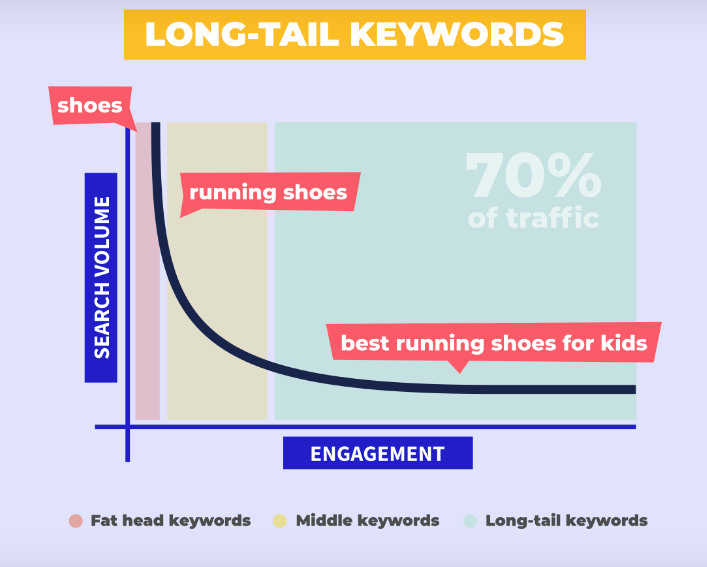
Increase conversions by targeting long-tail keywords
Most people try to describe what they are looking for in more detail when they know what they want. This means that long-tail keywords convert at a higher rate than head keywords (one to three words used in a search term).
The more words a person uses to describe what they are looking for, the more you can provide an accurate match as a solution to search intent. The benefits of long-tail keywords are:
- Higher engagement statistics
- Higher conversion rates
- Lower competition
The only downside to optimizing for a long-tail keyword is that they typically have less search volume. That being said, it’s better to get 10 people to buy your product out of 50 than it is to get 1 person out of 1000.
It’s much easier to nail search intent with long-tail keywords because the focus is much narrower.
For example, if a user were to search for summer shorts, there are a vast amount of options that this keyword could possibly mean. Does the user want spandex, cotton, nylon, a specific colour, style or fit?
If your website doesn’t sell every single option a visitor might be looking for when they search summer shorts, then driving traffic from this keyword would lead to high bounce rates and ultimately poor search visibility.
If your business only sells cotton shorts with various camouflage patterns, there would be no sense in optimizing for the keyword summer shorts, when you would have more success with terms like camouflage shorts or army shorts or more descriptive search terms.
When your products or service has a narrow focus, it’s a better approach to optimize for more accurate keywords.
Establishing a keyword strategy
Your keyword strategy should consist of keywords that are exact matches to your products and services to drive traffic with visitors with buyer intent. Your strategy should also include keywords that address the most commonly asked questions, common problems and the answers to those issues.
This type of strategy affords you the time it takes to rank for more difficult terms while ranking faster for long-tail phrases that ultimately lead to visitors on your main pages.
By assigning keywords topically, you can address more relevant issues and then find the best keywords that match your business through data-driven analysis.
Keyword tools are the most convenient at this stage of the process and can help finalize your target keyword in the content you publish.
Content Creation
To get your content to rank and outperform competing pages, it needs to be the best response to a search query. A large part of creating content that performs is figuring out whether you’re going to publish something unique, or whether you’ll publish something that’s just better than what’s already out there.
Analyze the top ten results for clues on search intent
One of the biggest clues to establishing search intent is in the page titles of the top ten organic results. The titles will show you what type of content has the best possibility of ranking highly.
Take the search term, how to rank a website for example.
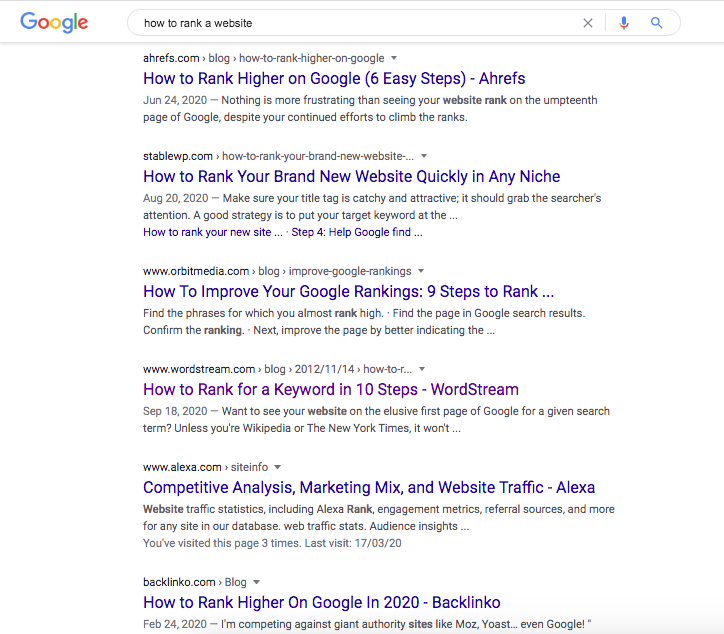
Out of 10 search results, 7 have titles that start with “How-to” indicating that the type of article users click on the most are how-to articles. This example is super obvious but the same holds true for any keyword in question.
Another example is to try searching the term drive more traffic.
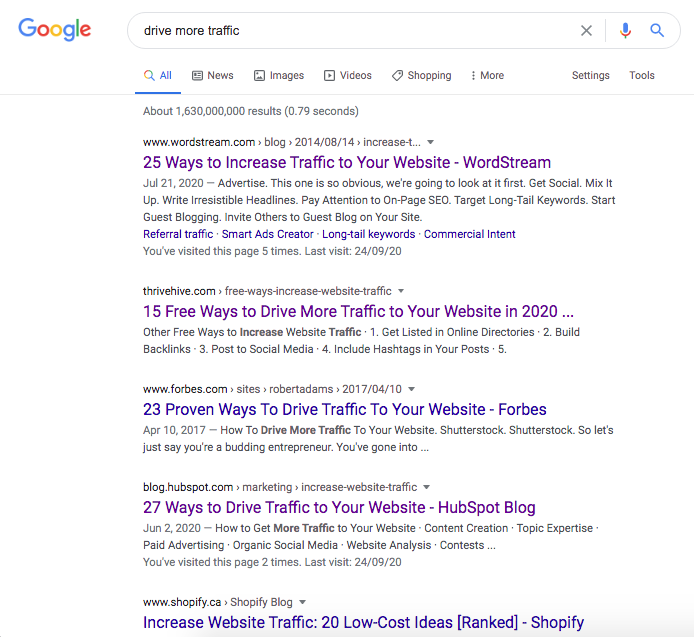
Again, 7/10 search results have titles with numbered lists that detail the different ways to drive traffic to your website. Evidently, the best opportunity to rank for this search term is to produce an article with a numbered list.
Analyze SERP features to improve your solution to search intent
There’s no one who understands search intent better than Google. Take into account the various SERP features that appear for your keyword. You can use the appearance of SERP features as clues to publishing content that is optimized to satisfy user intent.
Extract topically relevant questions and answers from the People Also Ask Box
The People Also Ask box, for example, is packed full of topically relevant questions that people also search in addition to searching for your keyword. If you can provide the answers to those questions within your page, it’s one less search your visitor would have to make and one more reason for them to stay on your page.
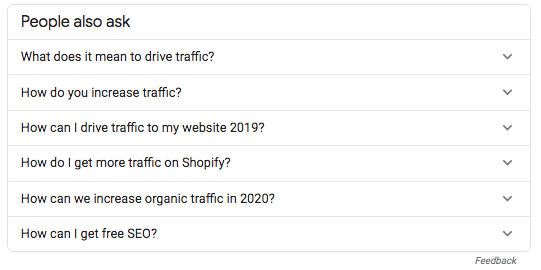
Incorporate the content from the PAA boxes to supercharge the number of topics your content covers as well as commonly asked questions. This content addition will make your page more user-friendly by directly answering popular questions.
Optimize your page with multimedia
If any videos or images appear directly in the SERP, it’s an indication that users are actively looking for one or both types of media. When Google is displaying a carousel of videos at the top of the SERP, it would improve your pages ability to have a video on your page as well.
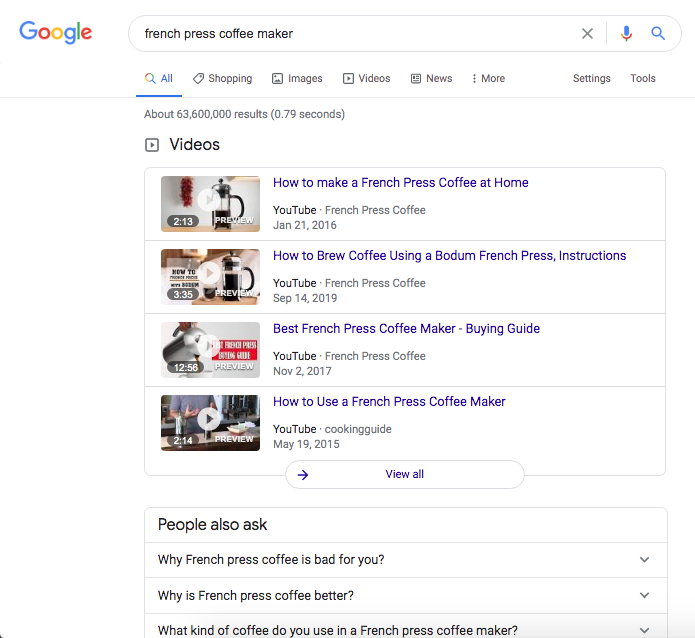
Outperform existing content
In order to outperform existing content, you need an accurate idea of what will make your version better than what’s already ranking.
You’ll need to determine the areas in which you can create a better piece of content.
Look to outperform existing content by publishing more in-depth content to better answer intent. Create more user-friendly features that lead to longer dwell time, higher click-through and lower bounce rates.
Reverse engineer top rankings
Create 10x content (content that’s 10 times better than what’s out there) by covering the details of every topic and subtopic on your competing pages.
If you use WordPress, copy and paste one of the pages that rank in the top positions. Click on the information icon to get a full summary of their article for a clear perspective on the word count, the number of topics covered and the hierarchy of content.
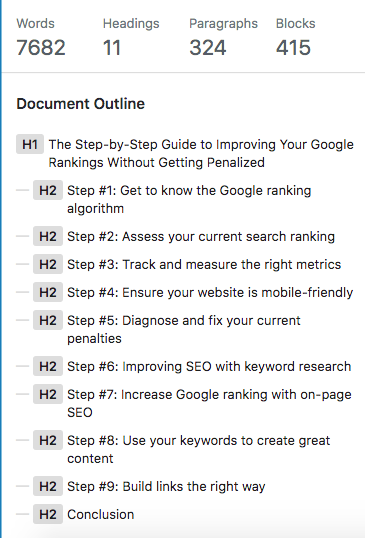
The information can provide you with a birds-eye view of how your competitor has constructed their page.
You can also enter a top-ranking URL in any analytic software that generates a keyword report. SEMRush will show you the value of organic traffic for any page.
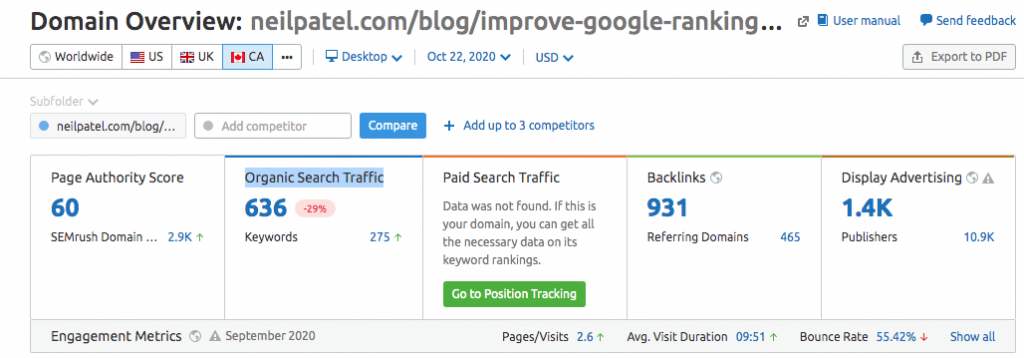
Click on the link and it will take you to another breakdown of all the keywords that URL is ranking for in the top 100 positions.
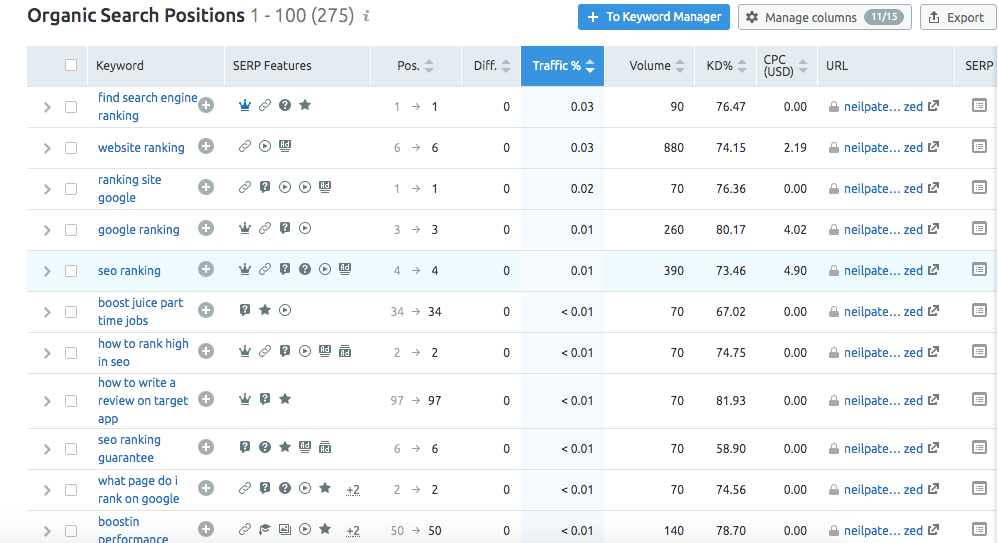
This report gives you insight into any gaps in content your page may or may not have. By identifying keywords you’re not optimized for, you also identify segments of content that will need to be added in order to meet and exceed the quality of the page that’s currently ranking.
Organize your site topically to enhance the performance of major keyword topics
SEO revolves around content because, without it, there wouldn’t be any SEO. Every page on your website should be optimized to target a specific keyword and play a role in driving traffic and converting visitors into clients.
An effective structure to implement in your content creation is to create topic clusters. A topic cluster consists of three different components; pillar pages, cluster content and the links that bind them.
A pillar page is typically a major keyword theme and it covers all aspects of that topic in breadth, but never dives deep into detail. Rather than cover every detail within the pillar page, a pillar page will link out to more narrowly focused articles. These articles are considered cluster content.
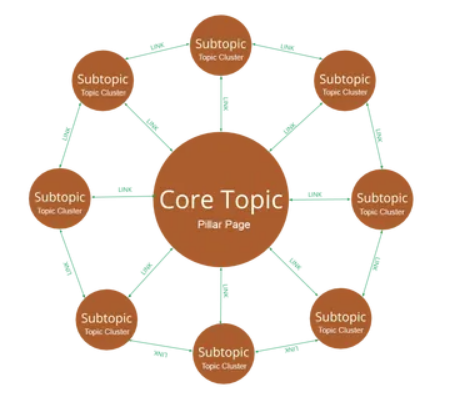
Cluster content, for the most part, targets a long-tail keyword and has a narrow focus on one specific topic. Cluster content goes deep into detail and attempts to fully answer the search intent associated with the keyword it targets.
A pillar page will link out to its cluster content and in return, the cluster content will link back to the pillar page. Cluster content will also link to related content within its cluster. This interlinking strategy is what forms a topic cluster.
The blueprint for your topic cluster is created within your keyword strategy. It begins with brainstorming the most important keywords to your website.
For every major keyword theme break it down into smaller subtopics.
Break down the subtopics into common problems faced by prospective clients. The collection of subtopics should adequately describe your business as well as provide ways for searchers to become aware of your product.
For example, if you were creating a top cluster for your dental practice, you might have the following pillar pages on your website: Cavities, Cleaning, Root Canals, etc.
For each of these pillars you would break down the topic into a number of different subtopics.
For cavities you might include the following as subtopics:
- How to know if you’ve developed a cavity
- Do filling cavities hurt after it’s finished?
- How long does it take to fill one cavity?
Potential keywords could be how patients are describing the pain they have. Keywords posed as questions “Why does my tooth hurt when I chew?”
Whether they know it’s a dental issue or not, a person will type in the symptoms they’re experiencing. Your cluster content would be optimized to address this issue and explain how your services can help them with their problem.
This type of content would be considered top of the funnel content to create awareness in your service or product.
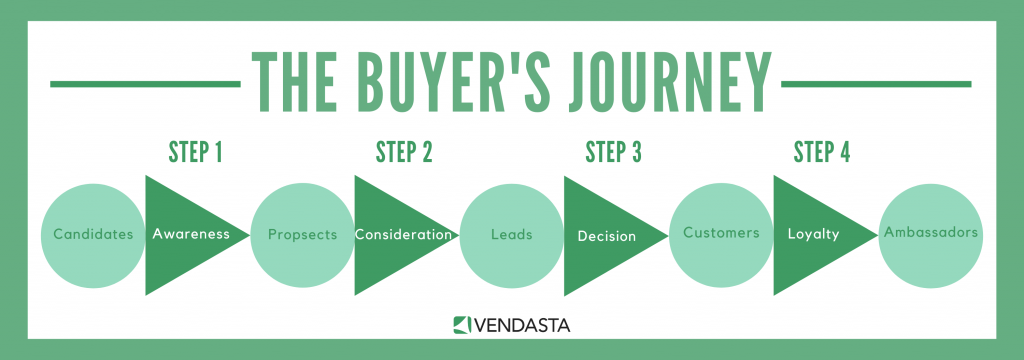
The content you publish on your site should start with the most important pages to your business. The pillars can be category pages, service pages, or landing pages to convert visitors to clients.
Build cluster content to lead visitors to these pages. This can often be done by targeting specific issues (long-tail keywords) as well as publishing comparative content that forces visitors to consider your company as the best choice.
On-page optimization
The contextual meaning of your content can be communicated through the metadata, text, images and structured data markup on your page. Using each of these aspects of your page allows you to highlight the most important keywords you intend to target in the search results.
Metadata
The metadata is extremely important because search engines will read and use this information to categorize your content. Including your keyword in the title, URL, image alt tag as well within the body of content will improve the optimization of your page for a specific keyword.
Text
Use your keyword sparingly in the body of your text. A common mistake website owners make is to repeatedly use the keyword excessive and unnaturally. This will over-optimize your page.
Make sure your keyword appears in the first 100 words or so and a few times within the body of the text. You can use keyword synonyms to enhance the optimization of your target keyword as well as promote a rank for secondary search terms.
Images
Despite the large leaps forward in technology, Google will still use the description in the alt tags as the primary clue for optimization. Use your keyword within the alt tag to enhance the optimization of your page, but this also optimizes the image itself.
Web pages aren’t the only means for driving traffic. Image sources can drive a huge percentage of your traffic if you’ve optimized them correctly.
Include the keyword in the filename, fill out the captions and give your image a descriptive title (avoid using the same words as in the alt description).
Structured data markup
The language of search engines, otherwise known as Schema, clearly communicates contextual meaning and other important information located on your web page. Schema.org has a list of entities that have been defined with appropriate markup and can be used on your page to break down any barriers of communication between search engines and your page.
Apart from providing a faster method of delivering accurate information, Google offers enhanced search results with the right markup. Google displays rich results for markup that informs search engines of reviews, FAQ sections, Q & A pages and How-to articles-just to name the top ones.
Rich results lead to higher click-through rates in the SERP by making your search result more marketable.
Off-page optimization
Anything that affects the optimization of your page, but doesn’t occur on your page is considered off-page optimization. This is largely the process of building external and internal links, but can also include improving technical performance.
Internal links
Internal links are among the easiest links to build because they are links to your page from within your website. Internal links create more link equity between pages, which can improve authority and ranking ability.
For example, suppose you have a page that converts visitors to clients really well. Let’s imagine it’s a product page for an incredible razor that does things that you only imagine in your dreams.
The problem is, it’s difficult to get external websites to link to your product page, so how do you get it to rank and generate traffic?
Enter internal link building.
Based on the topic cluster model, you can create content that external websites would be more likely to link to because they provide objectionable value. An article on 10 Ways To Reduce Shave Time And Frequency would be good content asset and has more rank ability then a page with just a product.
By building links from the pages that generate the most traffic, to the pages that convert at the highest rates, you can increase the number of visitors you convert as well as give your product page more authority to rank.
You can also use internal links to optimize for your target keyword by using a mix of exact match anchor text links as well as long-tail anchor text links and keyword synonyms.
External links
As one of the most powerful ranking factors, external link building can create a top-ranking page-even if your content isn’t technically “the best” stuff out there. With enough websites vouching for your credibility, you can literally rank a page for just about anything as long as you have really good links.
Using keyword-optimized external links will enhance the optimization of your page if done correctly. If you only use exact match anchor text, you may end up over-optimizing your web page. This will send your site back in the search results.
Using a mix of exact match, branded, naked URL and non-optimized anchor text will give your page a good balance of in your backlinks profile and promote a healthy ranking for your target keyword.
Social media marketing
Traffic generation is a huge component of SEO, which makes social media marketing an important aspect of your overall SEO strategy. Building a large audience can serve as a way to drive instant traffic to your web pages and get your content in front of a large number of people.
Despite the fact that links from social media don’t count as followed links, there is some value in the user engagement that social traffic creates. Google rewards pages that have high click-through rates, dwell times and low bounce rates.
The law of averages dictates that the more traffic you send to your pages, the more likely you are to acquire backlinks to high-quality content. Social media can drive the additional traffic needed to get you more backlinks.
The incredible number of users on Facebook is enough to make it an attractive source for marketing your business. Facebook is not the only platform that has proven success in building a business.
Retail sales and B2C marketing do especially well on Pinterest and Instagram. Your target demographic will influence the social media website you choose to implement in your marketing.
B2B sales may have more success with websites like Linkedin.
Social media offers a way to market your product for absolutely no cost whatsoever. If you can produce highly engaging, top-notch content you can build a massive number of followers with absolutely zero investment other than time and effort.
Of course, you can also dive into the paid aspect of social media marketing, after all, you’re targeting the same audience that you want to get reading your content. One of the most effective forms of paid traffic is using retargeting.
Retargeting ads will only re-appear to a user once the user has clicked through to your website. Once that happens, the pixel installed on your site will automatically upload a cookie into the user’s browser. Whenever there’s an opportunity for an advertisement to appear, your ad will reappear for however many times you stipulated in the settings.
This is a highly efficient way of getting people more familiar with your company, which opens them up more to doing business with you.
Technical performance
The technical performance of your website can be improved when you know where to make the improvement. In an effort to monitor the various technical aspects of your website, you can run an audit to determine the page speed, the number of broken links, missing metadata, missing pages, duplicate content and indexing issues.
Page speed
The length of time it takes your page to load can greatly affect user experience as well as your ranking (if it’s excessively slow). You can work on page speed by fixing both on-page elements as well as off-page elements.
Reducing the size of your files, compressing your images, and implementing lazy loading can greatly reduce the time it takes your page to load.
You can also use a CDN, inline the HTML, CSS and JavaScript in the header to reduce the time it takes to load. Leveraging browser caching is another one of many tactics that result in faster page speed.
Reducing errors
Every website eventually begins to generate errors with everyday use. Even if you don’t use your website at all and don’t update it, there will eventually be errors generated from incompatible versions of plugins, themes and browsers.
The accumulation of errors on your site can lead to a reduction in the ranking.
Many of the errors that result in a drop in ranking are based on user experience, such as broken links. When a user encounters a broken link, it’s frustrating and causes a slight problem in the fact that the user needs to back up and decide on where they’re headed again.
Having a missing page on your site results in a 404 error message. This can also look bad on your brand and your company could be misconstrued as having a low-quality website.
Fixing broken links and eliminating missing pages is one of many ways to improve the user experience and overall website performance.
Data driven results
Search engine optimization is a highly effective means of marketing for more reasons than just optimizing your pages to appear first in the search result. SEO involves recording, measuring and tracking results, which can give you better insight when making decisions.
Analytics
Google Analytics is one of the most comprehensive tracking software available that comes absolutely free. Once the tracking code is installed you can monitor the volume of traffic, the origin of that traffic and what those visitors did once they were on your website.
Each month you can see how much your traffic is growing and whether the traffic your building is impacting your bottom line. This can give you insight into the effectiveness of ranking keywords and gauge the impact of any SEO campaigns you’re currently engaged in.
Goals and conversions
Creating goals and conversions in Analytics can contribute to establishing better paths within your site to guide visitors to a preferred action. You can track the pages that users click-through to as well as where they drop off.
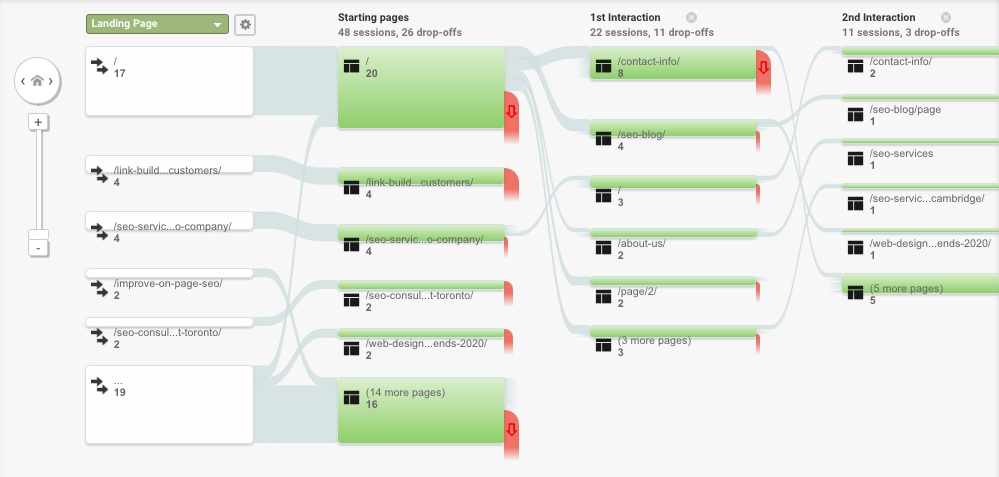
Creating goals is a way to measure the success of your SEO campaigns. By improving on the number of drop-offs you can lead a larger percentage of visitors to pages that help in achieving more conversions and complete more goals.
Compare past and current performance
You can also monitor the traffic on individual pages. This tool allows you to compare any time period with each other to see whether your traffic is above or below the past period’s numbers.
Search console
Search console (another free tool from Google) allows you insight into the performance and health of your website.
You can check to see what queries your pages are appearing for and of those queries how many clicks you earned to your website.
You can build more keyword ideas and content around successful keywords based on the information provided in this tool.
Technical error alerts
The search console informs you of technical errors on your website and will list the URLs of the pages that need work. If your page speed is abnormally slow you can see what pages need improvement.
If your site receives a manual penalty, the search console is the first place to look to confirm whether this has happened. In fact, it’s the first place to look if there’s a sudden drop in traffic since you can see the number of URLs you have indexed as well-just in case the unthinkable is happening and your pages were being taken off of Google’s index (it happens!).
Monitor backlinks
There is a list of the most linked pages as well as the websites that link to you’re the most. You can monitor what backlinks you’re receiving at the fastest time possible since there’s no search engine spider that would know you have a backlink before Google.
Make data-driven decisions
The SEO tools available are numerous and there are more than enough to extract the data you need to make the best decisions for your business. Having insight into the success or failure of specific efforts can save you time and resources in the future.
Analytical tools help to streamline your efforts in creating a more efficient and more effective website that generates traffic leads and new clients.
Implement SEO basics at the earliest stages of development
Search engine optimization is a long-term strategy that can sometimes have quick results. Learn the most important sources of traffic for your business and develop your website to tap into those sources.
Authoritative content is by far the largest ranking factor when it’s optimized to answer search intent. Creating content assets doesn’t immediately translate into massive streams of traffic-there is a period for that content to settle and make its way to the top of the search results.
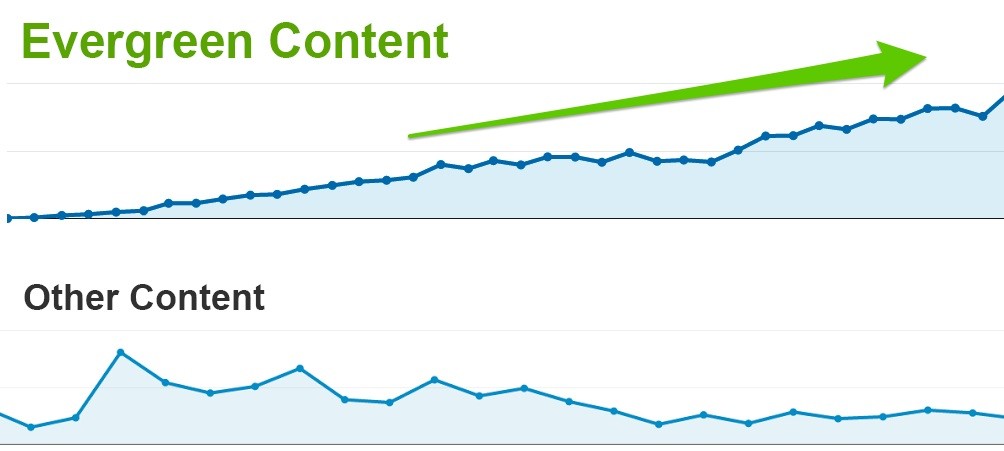
Strategize your keywords, content and link building strategies. The earlier you begin, the sooner you’ll reap the benefits of a well optimized website that generates high converting traffic and contributes to more leads, and revenue.
Local SEO For Small Businesses [2020 Update]
Generate sales and new clients within your city with local SEO for small businesses. We live in an age where digital marketing is a massive source for driving new business. More than 90% of people will use their phones to research and make a purchase. Capitalize on the power of local SEO for small businesses and dominate the search engine results in your city.
Local SEO for small businesses is not just about ranking on Google. Although Google controls most of the search engine market, there are still many other ways people search for local businesses such as Yelp, Bing, Yahoo!, etc. For this reason, this article will mainly focus on ranking on Google, but also on using alternative ways to supplement your streams of traffic.
This guide will take you on a step-by-step tutorial on how to get your business up to speed as well as how to compete and outperform your competition in the localized search results.
Google My Business Setup
Setting up your GMB account is fairly straightforward. You’ll need a Google My Business account so head over to Google My Business to get the process started.
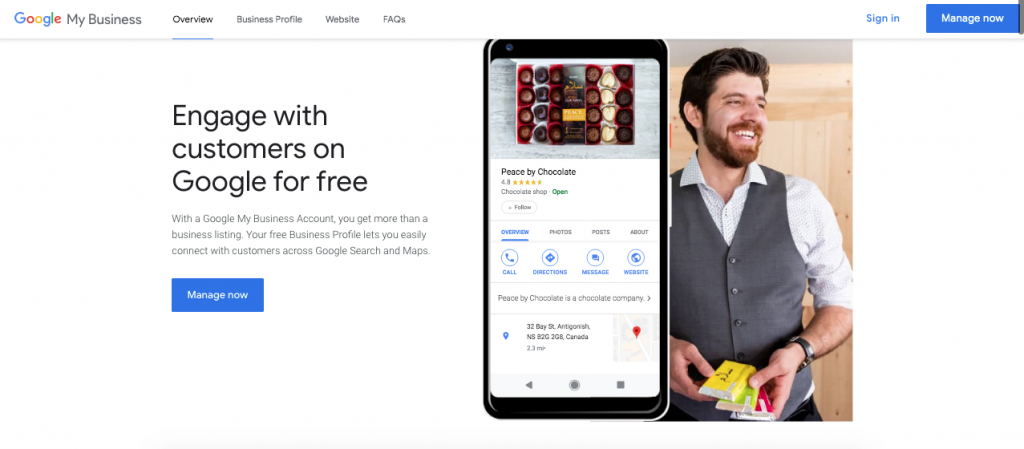
You’ll be walked through a series of steps to create your profile with all of your business information. Although you can always switch the primary category you initially select, you should know that choosing the most appropriate category can greatly affect your search visibility. If you choose the wrong category, Google may not associate your business with relevant keyword searches.
You can confirm you’re in the correct category by searching Google for your keywords and then scanning the competing GMB listings to see what category they’ve selected. If you see a lot of your competitors with the same category, it’s a safe bet that’s the same one you should be choosing.
For example, if you’re a landscaping company, you have a few options to choose from such as Landscaper, Landscaping design and Landscaping architect. Make sure the category you choose puts you in competition with companies that offer similar services.
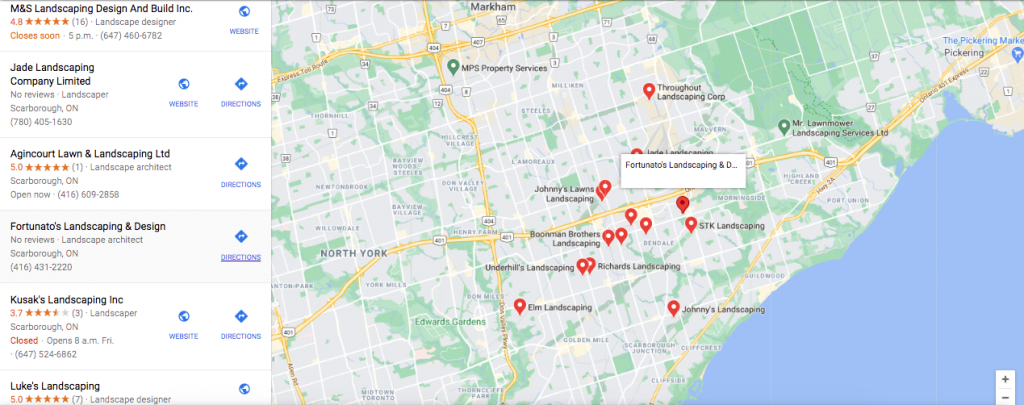
In order to make any changes or additions to your profile, you’ll need to verify your listing which is done via phone call or postcard.
When entering the address for your business make sure you submit the actual business address of your company. You may need to move the marker on the map if Google got it worng-so double check just to be sure.
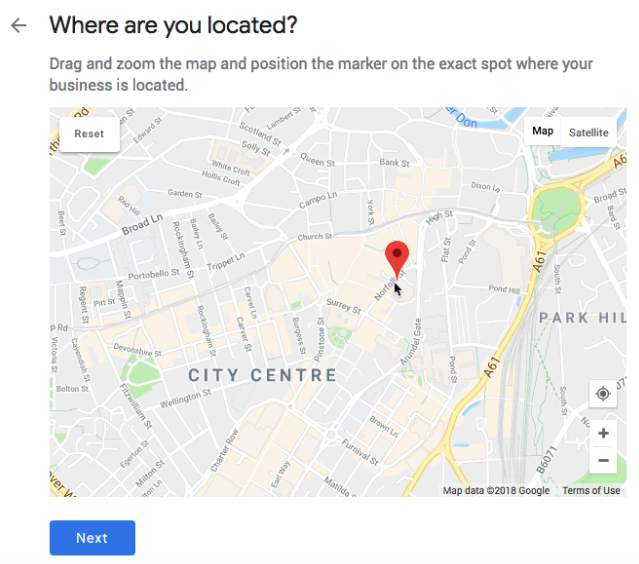
If you’re a service area business, you can use your home address. Just select the option that indicates you deliver to your customers.

If you don’t offer services at your home and therefore don’t want your home address displayed, there is a button you can select that will hide your address and display your service areas.

If you happen to have partners in your business or have multiple physical addresses, choose the one that’s closest to the centre of your target city. This will promote more appearances by being centred in a more densely populated area-even if you’re selecting a service area business.
Optimize your account
Optimizing your account is as simple as filling in every field that you can possibly provide information. When a search is made on Google, the information from your GMB profile is pulled to associate your company with keyword related searches.
Make the effort to include as much information as possible to give your website the most opportunities to appear in localized search results.
Upload photos to GMB
This may seem like an unimportant aspect of building your profile, yet it’s one of the most viewed components when customers are researching your company. Include as many images of the interior and exterior of your place of business.
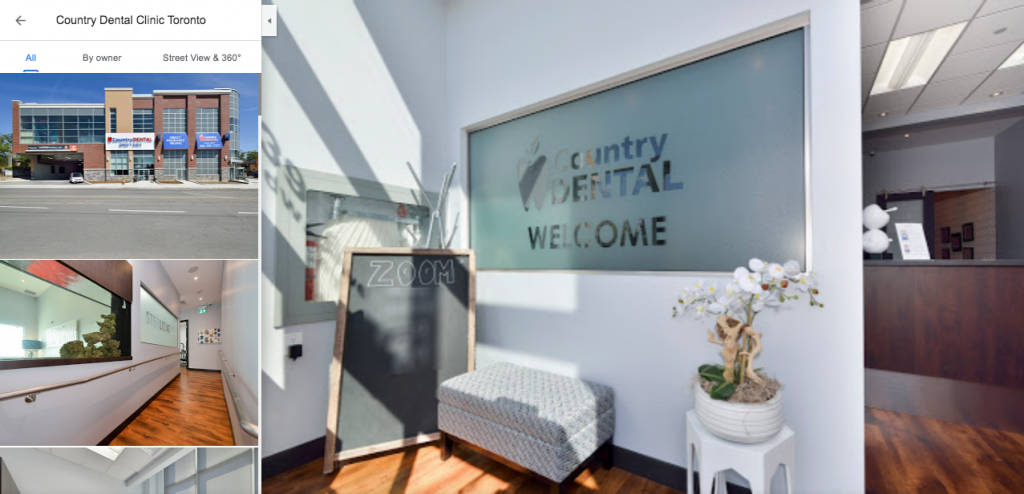
Upload product images or examples of work you’ve performed to give your potential clients a sneak peek at what your company offers.
Publish microposts
There is a small correlation between staying active on Google posts and driving more traffic. Although posting regularly may not improve your actual ranking in the local finder, it does help to take up more real estate in the search results.
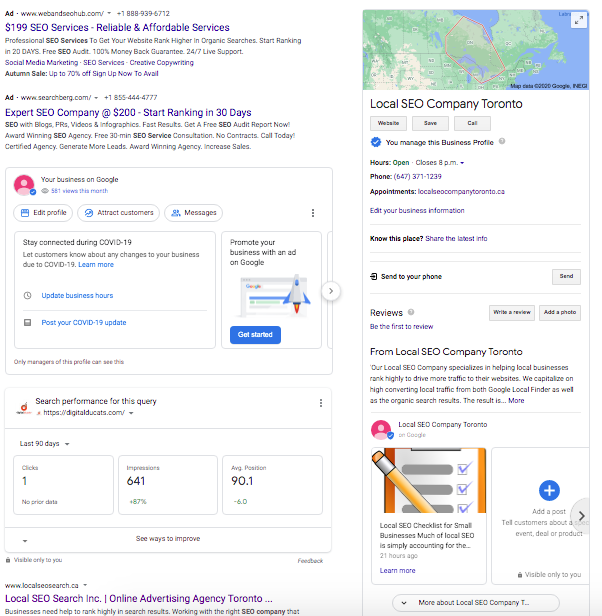
Increase the click-through rate to your website by publishing microposts to your profile on a weekly basis. A high res image and catchy title will help to improve your CTR.
Bing Places For Business
When you’ve verified your profile on Google, claim your business on Bing places for business. Bing’s search engine only accounts for less than 10% of all local searches in Canada, but why not welcome the additional traffic to your website?
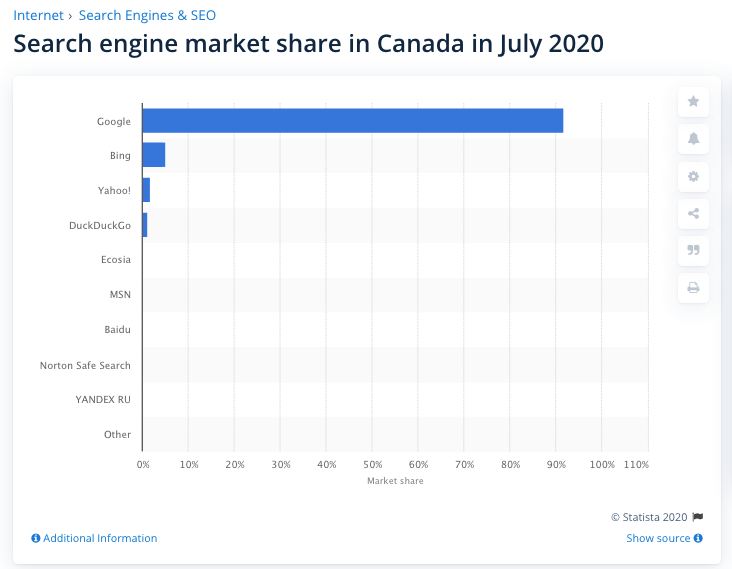
Once you’ve begun the process of claiming your business, Bing will search for your business to see if a listing already exists. If you don’t see your business listing you can go ahead with creating a new profile.
You’ll be given the option to import data from GMB. This will save you time in creating your profile and ensure your profile information remains consistent (no typos). Choose the option to have your data imported and sync your accounts.
Apple Maps
Think about how many iPhones are in circulation. Apple sold over 40 million iPhones in Q1 of 2020. Although most people may prefer to use Google Maps, Apple Mpas is the default system for providing directions whenever you ask Siri. There should be no doubt about it, listing your business in Apple Maps will result in additional traffic to your website.
There are millions of searches that are being made through the Apple Map platform, so why not capitalize on the searches that are being made in your city? You’ll need an Apple ID to register your business.
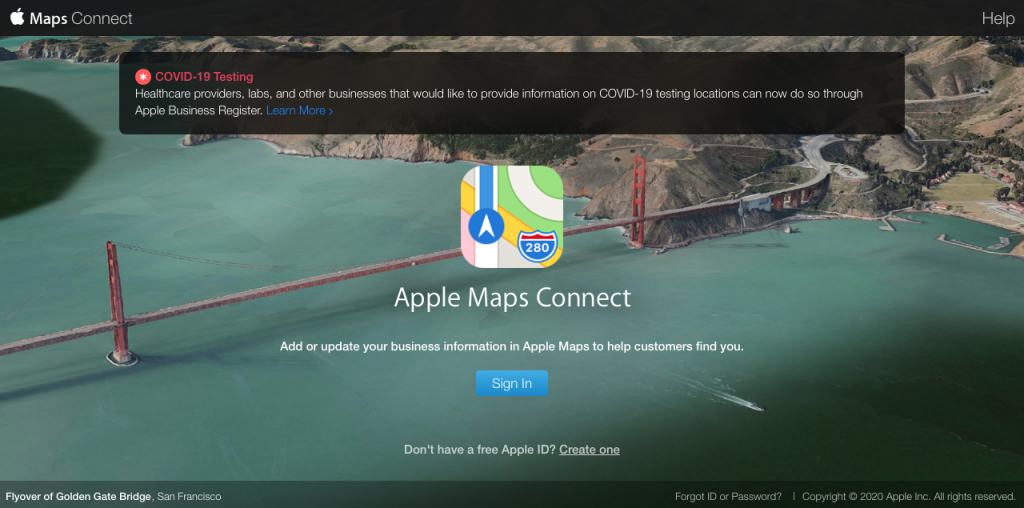
Structured citations
A structured citation is an instance of your business details being posted to a website. It is considered structured if there are specified fields to enter your name address and phone number (and website). Directory listings, profile links, review websites are examples of where you can find structured citations.
Listing your business in directories has a twofold effect on your website:
- Structured citations strengthen your position on Google’s Local Pack/Finder.
- Directories provide relevant local referral traffic.
Structured citations confirm your NAP details (name address and phone number). Google verifies the validity of your NAP details with credible citations, and as a result, your search presence in the Local Finder/Local Pack improves.
Choose major citation websites as well as niche-specific and location-specific to create a positive ranking signal for your website in city-specific searches.
Major citation websites
Major citations for your industry and country can be found on Whitespark.ca You don’t need to add them all at once. In fact, it may be better to limit yourself to adding 10-15 a month.
Niche-specific citations
Identify a minimum of 3 niche-specific directories to enlist your business as a start. You can use a simple Google search to find the most relevant directories. A popular search would be:
[your keyword] + business directories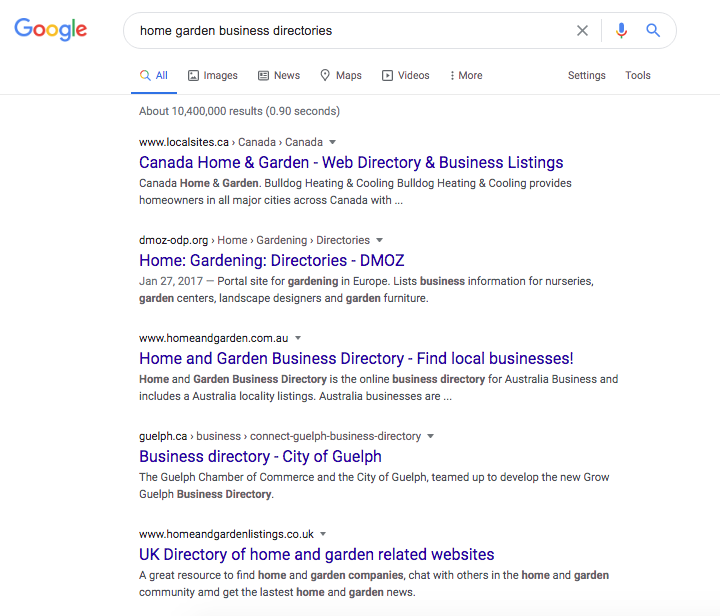
The results may not be within your location, however, the search should uncover some of the larger niche directories in your industry. Choose three to start and perform your next search for local directories.
Location-specific directories
Search for the most popular city-specific directories with a simple Google search:
[your city] + business directoriesPRO TIP: Download the Mozbar browser extension to filter out the low-quality websites along with those that are heavily spammed. The Mozbar will indicate the domain authority (DA) which you should keep at a minimum of 15 DA at the lowest. Spam scores are naturally high for directories so you may need to concede in this area.
Here’s a search for Toronto business directories in which the result are displayed with the Mozbar:
At a glance, you can see that only the first and third results would qualify as citation prospects. The second search result shows a DA of only 14 (The PA is the page authority).
Some directories you will need to pay to join. These are probably good directories for your website but you don’t need to pay to get what you need from structured citations. Avoid it if you’re on a tight budget.
The second qualifying metric you want to double-check is the amount of organic traffic that flows through the directory. If a directory gets little to no organic traffic, it’s a red flag. You don’t want your website to link from graveyards or heavily spammed sites and organic traffic can tell you whether you’ll get some referral traffic on top of the citation.
There are many analytic tools you can use, but SEMRush offers a free version that gives you the numbers you need. Plug in the URL of the website and the overview will display the approximate organic traffic the website receives.
This value indicates whether the website ranks organically for keywords and does in fact drive traffic that can be beneficial to your website FYI, the above directory would be a terrible directory to list your Toronto business.
On-page optimization
The optimization of your pages is crucial to appearing for city-specific searches. Create a strong competitive advantage by making sure your keyword is included in your metadata as well as within your content.
Local SEO keyword strategy isn’t extremely complicated as it’s basically [your product or service] + [your city], and similar variations. If someone needs a plumber in Toronto, they’re going to type “plumber Toronto” or “plumber in Toronto” or “Toronto plumber.”
If your business services one city, optimize your homepage to appear for your product/service plus your city.
How to optimize your homepage
Make sure the most important pages are a click away for users landing on your homepage. Include a navigation bar that hosts the service and product pages that you want people to easily find. Highlight your most important products with blog posts that feature related content (preferably geared towards converting visitors to clients)
Include the NAP details (Name address and phone number) in the footer so the company address is present on every page of the website. Embed a Google map so users are able to click on the map for directions to your storefront.
If you operate a service area business then you may want to create location pages to give your website the most competitive advantage in appearing for each of the cities you service.
Location pages
Your company should have a separate page for every city you provide service in-especially if you have multiple physical locations. Each location page should be published with unique content. Never duplicate the same pages while only changing the city.
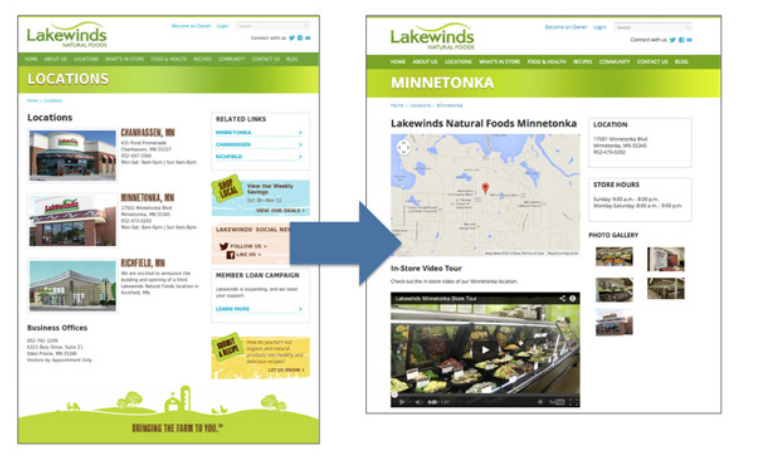
A good location page will reference the city with landmarks or any unique identifying content that can be associated with that area. Include the address, phone number and a map of each location to create more local relevance and a stronger position in the search results.
A location page gives you the opportunity to include the keywords in the most important places such as the URL, title and meta description. This enhances on-page optimization which is a large factor for ranking local websites in localized search results.
Local content
Location pages are considered local content, but apart from your location page, you should be publishing regular content about your business and city. Here are a few examples of the types of content you can produce that positively impact your local search visibility.
Client surveys
You can survey your clients on just about anything related to your product or service. One of the major benefits of surveying your clients is identifying their personal preferences, like dislikes or even just getting their opinions about a particular issue.
Knowing the preferences of your clients are a huge asset to providing an exceptionally high level of customer service. You can cater to the needs of your more closely and discover areas that may be hurting your business.
Additionally, a survey will contribute to creating high quality content based on the results. You clients would be absolutely interested in the experience of fellow clients using your product or service.
Expert roundup
An expert roundup is another way to bring more attention to your company while building local alliances. If you’re strategic with your content you can get a lot of companies that aren’t direct competitors, but operate within your field of expertise to participate in a roundup.
This could be an expert opinion that you collect from each of a number of businesses on a trending topic. An on-site example of this can be seen in the infographic we designed titled, “12 Web Design Trends For 2020 By Toronto Experts”.
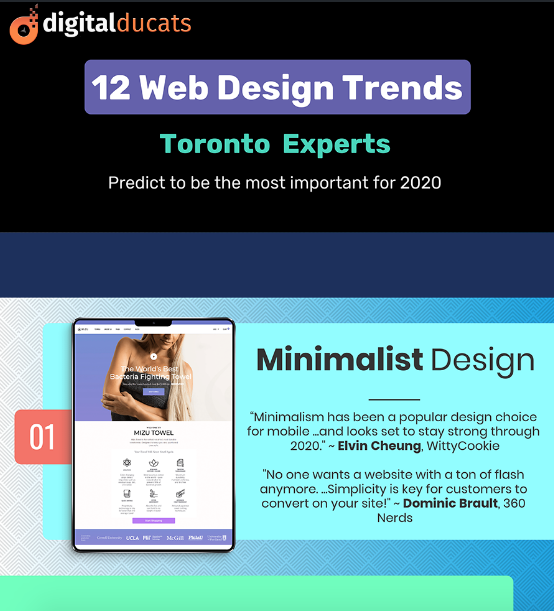
As an all SEO company in Toronto, we are closely aligned with web design companies, however, we don’t offer the same services. In this expert roundup, we gathered the opinions of 18 different web design companies on what each expert was the most important web design trend in 2020. We then designed an infographic with an answer from every expert.
The infographic was not only shared by many of the experts who participated but attracted a large number of backlinks.
Local events
Whenever there’s a local event worth mentioning, post it on your blog. The publication of local activities in your city creates strong ties to your locality. Be sure to include the relevant NAP details and link out to the local sites that are involved in the event.
Host a local event
If your company is hosting the event be sure to post the details on social media, local event websites and community bulletins. Get the word out to as many local people as possible to promote your business and create a few more backlinks to your website.
Post details on Eventbrite.ca if it’s large enough. You can also use Meetup.com if or a similar site if you’re holding regular meetings. Keep in mind that meetings don’t have to be in person. Virtual events are also fair game and equally worth writing about.
Sponsor a local event
You don’t need to hold an even all on your own. You can also look for events that are related to your area of expertise and apply to sponsor the event. Again, Meetup.com is a great site to use for finding events to sponsor, but you’re not limited to Meetp.com as there are a bunch of similar sites to choose from.
To find what events are looking for sponsors type in this search operator into Google:
site:meetup.com + inurl:sponsor
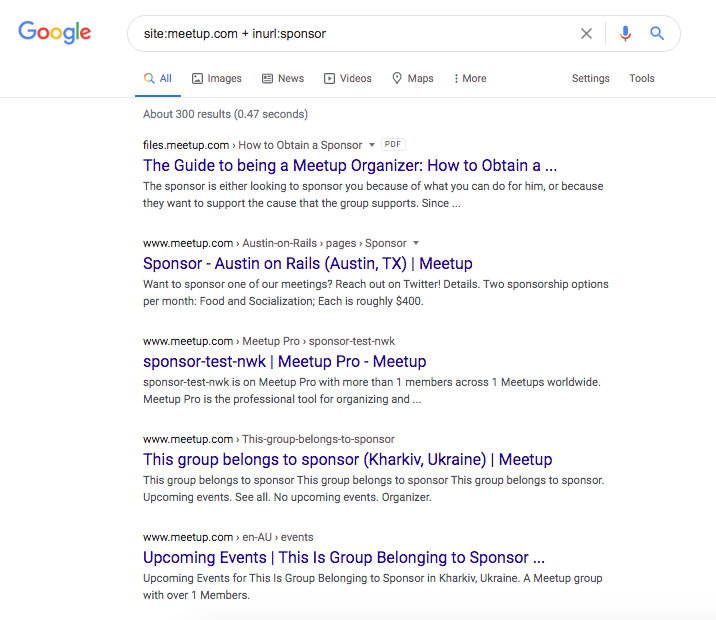
The search results should be a list of pages that have the word sponsor in the URL. Here is an example of a sponsor page for a Toronto group:
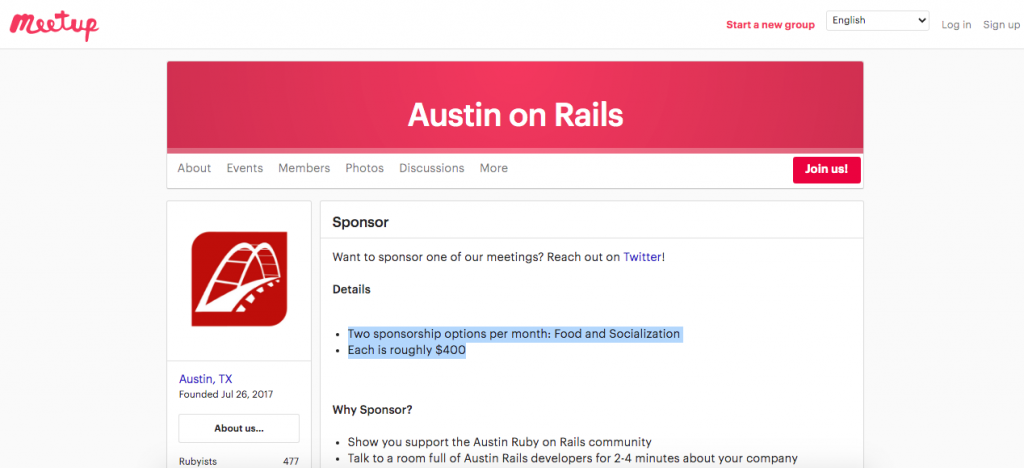
Choose events that are worth talking about on your blog. Although the bonus to sponsoring an event is you get a backlink to your site you still want there to be a strong relationship between the content of the meeting and your business..
Unstructured citations
When your website’s NAP details appear on a website that isn’t formatted specifically for listing company info, it’s considered an unstructured citation. This can be any one of the NAP details as seen here in the Kingstonist magazine for the Integrated Care Hub. This particular citation includes the name and address.
This does provide value however, obtaining a link from an unstructured citation is the most valuable of local backlinks.
Unstructured citations are found in local news websites, local business websites and local blog sites. These links are considered la crème de la crème of backlinks and will have the greatest positive impact on search visibility as far as quality backlinks go.
Publish local content to attract unstructured citations
Publishing local content will contribute to obtaining unstructured citations. For example, in your expert roundup you may be able to get a few businesses to link to your site within their content.
Asking for a link is a much easier discussion with a website owner when the link you’re asking for points to an article that they’re featured in on your site.
Gain citations from local news sites
If your business is involved in activities that give back to the community, it might qualify as newsworthy content. For any charitable activities your company might be involved in, you can send a few local reporters a news tip on what your business is doing and see if there are any bites.
Local journalists will typically write about any community news as long as it’s not overly promotional and there’s something worth telling the community about.
Local blog site citations
There is a ton of people blogging in your area-unless of course you live in the North Pole. Find bloggers interested in talking about products, services or topic-worthy issues associated with your business.
If your business is in garden maintenance, find which blogs would publish a few amazing tips that no one heard of before. Many bloggers/influencers accept products in exchange for a review, mention or a link back to your website. Contact influencers and bloggers whose audience is the right fit for your business and they have a substantial following.
Maximize revenue with a local SEO strategy
There are a lot of moving parts to create an effective local SEO strategy, but the rewards are well worth the investment.
Remember that although Google may account for the bulk of the local traffic you receive, there are many other ways to add valuable streams of visitors to your website. Make use of all the options available to create high volumes of relevant local traffic to your site.
SEO Case Study: 200% Traffic Growth In 4 Months
There’s nothing like good, hard evidence of how SEO provides a return on your investment. The following is an SEO case study on a local home goods supplier in which we achieved an increase in traffic of over 200% in just four months’ time.

A brief history of the clients’ website
The company sells patio furniture, hot tubs, barbeques, billiard tables and more. The client began services with Digital Ducats after working with an SEO Toronto company for almost 5 years.
Their website had a number of backlinks and they had published content on their blog continuously during the last four years.
After a website assessment, it was determined that although they were ranking for some keywords, many of their pages were lacking on-page optimization. Most of their blog content was low-quality and not good enough to rank on the first page of Google.
The Google My Business profile was loosely put together and was lacking optimization wihch was resulting in low search visibilty in Google’s Local Finder.
The main objective
The ultimate goal for this SEO case study was to push the websites ranking up to the first page of search results. We wanted to create a stronger search presence for the keywords that would drive the most potential clients.
The objective was to increase revenue using a content-driven strategy. The goal was to build awareness and drive traffic using keywords to rank for content that satisfied users at the informational/research stage as well as the buyer stage.
The SEO strategy explained
A competitive analysis was performed on the top ranking websites in the niche. In order to create a more competitive website, we needed to establish how the competition had achieved its top ranking in terms of content, site structure, link building strategy and optimization.
The results of our keyword research provided the basis for the content that needed to be published to drive traffic with buyer potential. A content audit was performed to identify the pages that could be enhanced to rank higher.
The SEO campaign included:
On-page optimization
- Meta tag optimization
- Titles
- URL structural analysis
- Internal link strategy
- Topical organization
- H tags
- Canonical references
- Outbound links
- Schema
- Structured data markup
- HTML code cleanup
- SERP feature optimization
- Page speed optimization
- Mobile optimization
- 301 redirections
- 404 Error corrections
- Robots.txt review
- Sitemap creation and submission
- Install Google analytics
- Set up Google Search Console
- Google My Business Optimization
Backlink strategy
When we first began work for the client, the backlink strategy was already mainly composed of directory links and citations. We started with:
- Toxic link removal
- Niche and local citations
- Links from niche blog sites
- High authority links from appropriately themed websites
SEO Case Study results
In between the third and fourth months, the traffic for our client had nearly doubled in multiple categories when compared to the same months from the previous year.
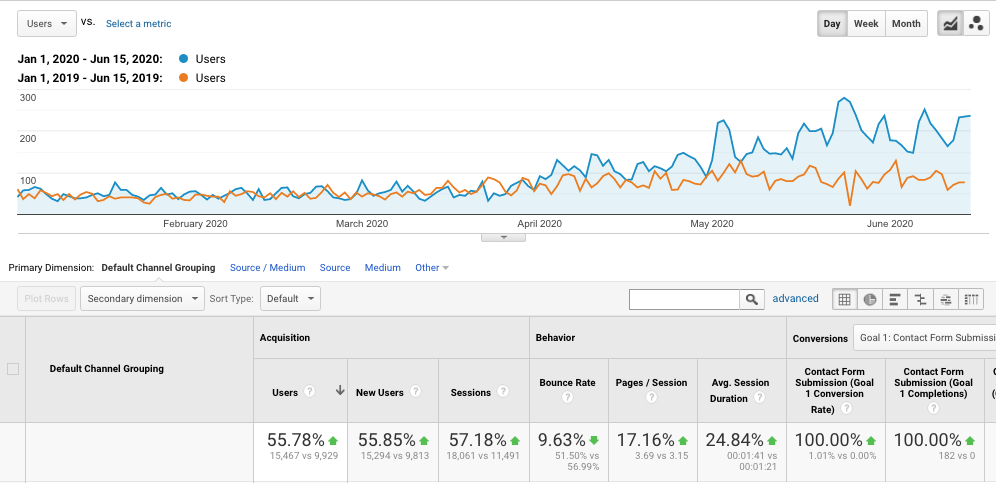
The number of keywords that our client ranked for went from 300 to 700 and we improved our client’s position on the first page for multiple search terms.
Organic traffic was literally doubled when compared to the same time period the previous year. The website had received 7744 visitors in the previous period which has increased to 13,521 visitors

Although the results for this client only took 4 months, it should be noted that the expected time to see the full results lies somewhere between the six to nine months range.
Digital Ducats Inc. is one of the best choices you can make for your business when it comes to investing in a marketing strategy that produces results.
Claim & Optimize Your Business Listing On Bing Maps
Appearing in a local pack or local map listing on any search engine can be one of your greatest sources for high converting leads. Claim and optimize your business listing on Bing Maps in order to maximize your search presence, improve your local SEO and drive more high-converting traffic to your site.
People who are searching for local businesses are typically looking to make a purchase in the near future. Believe it or not, people actually use Bing and Yahoo to search for stuff!
Despite Google’s domination in the search engine market, Bing still carries a percentage of searches that are valuable to every business. In March of 2019, approximately 6 billion searches a month were made on Bing, which currently holds approximately 33% of the desktop searches in the US.
What’s more, is that Bing is a major directory that Google uses to confirm the authority and credibility of your business’s NAP details. The name, address and phone number should be consistent across the board. Every directory and review site should have correct and up to date NAP details to avoid confusion from users looking for your business.
If you haven’t claimed your Bing business profile, doing so will help you manage the information to better match your Google My Business profile and every other citation built on your company.
Here is a step-by-step guide on how to claim your listing and create a stronger local presence by completing and optimizing your profile.
How to claim your listing on Bing Places for business
Go to Bing Places to get started.
Since you’ve never used Bing before you’re going to select New User.
The next screen you’re faced with a decision. To either import your business from Google My Business or start new.
By opting to import your GMB profile
You will already have many of the fields filled out for you. This eliminates the possibility of making any typos when you’re completing your profile.
This also saves you time.
This also gives Bing the power to read and edit your data on GMB. Despite the ominous gift of power you’re donating, it’s reasonable to import your data and avoid the extra headache.
If you use this option you don’t need to go through the entire verification process.
By opting to claim or add your business manually
To claim and optimize your business listing on Bing, you’ll need to go through some additional steps to get your business listed with the correct details.
Apart from filling in your company details, the main time-consuming factor is the time it takes to verify your information to make your profile live on Bing.
How to add your Bing listing manually
If you opt to add manually, the first question you’ll need to answer is about the type of business you’re adding. Enter the appropriate answer from the drop-down menu.
Make sure the country is correct in the next box and you will be prompted to search for your business.
This is to see whether a profile has already been created. Enter your business name and the zip/postal code or city and state/province in which your business is located.
If you see your company name in the list of options that are presented, click on it to edit the profile.
If your company is not in the list of options, scroll all the way to the bottom and select the box that says My business is not listed in the search results.
A box will immediately appear for you to modify your search or to create a new business.
If you’ve spelled your company name correctly and it hasn’t appeared, select create a new business.
You will be asked to log in using one of the following platforms:
It doesn’t matter what you select, but if you want to sync profiles or manage multiple profiles, choose the platform that you use the most (if you have a GMB profile it would make sense to use the same account).
Optimize your Bing Places profile
You will be brought to your first screen, which should be fairly straightforward to fill out as it is all basic company information.
If you don’t have a location where you serve clients (you operate in service areas eg. Locksmith) there is an option to select. However, you will still need to enter an address where you receive mail to verify your business.
The next screen will dive a little deeper into how Bing identifies your company. You will be asked to select your segment of business.
Choose the most appropriate segment that best represents your business. These are the main groupings in which you will further define in your next selection for your main category.
After choosing your segment, choose your primary category in order to optimize your business listing on Bing.
Getting these categorizations correct is extremely important in order for the search engines to properly place your website in keyword-related searches.
If you don’t see the main category of your business, you may not be in the right segment.
For example, if you chose Business-To-Business as a segment-you wouldn’t find website design in the next dropdown to select the primary category.
You would need to go back and choose Professionals & Services as your segment in order for Website design to appear in the Primary Category dropdown.
If there is any uncertainty about what your category is, do a Bing search for businesses like yours. You can check how they’ve categorized their profile from the local listings themselves.
Once you’ve moved on to the next screen you’ll have the option of listing your address publicly or privately. If you don’t have customers visit your business address click the option to hide this address in the search results.
Fill in your contact details. The more information you provide the better.
Add images to your profile. This may seem optional but images can have a big impact on how prospective clients view your business. Adding images will help to give your company more credibility and instil stronger feelings of trust.
Add your business hours. If you type in the times for Monday before you open any other days, they will all open at the same time you typed into Monday’s slot. This saves you a bit of time searching the drop down for each day.
Make sure your hours are the same on your website, GMB profile and any other citation you’ve built with the operational hours of your business.
Click Submit to complete the last section for optimizing you profile.
Verify your business on Bing Maps
Choose the method of verification that works best for you. You can elect to have a postcard sent to your address or can download the Bing Places App and verify over the phone.
The postcard can take as long as two weeks to get to your address.
Downloading the app is significantly faster since your listing can be approved in only two days.
Note: If you’re using a computer-generated number to verify your business through the app-it won’t work. You need an authentic landline or cell phone number to get the phone call from Bing.
If you’ve entered a legitimate cell phone number or landline, a machine will call and give you a confirmation code to enter in order to verify your listing. You can also opt for an SMS text message.
Once verified there you will be one more review of your business before it become official. You will be notified by email (or App) when you’re business listing is officially live and on display.
Encourage reviews and keep your NAP details up to date. Bing Places is a major directory that feeds a number of other data aggregators. Incorrect information on your Bing profile will ultimately filter through to other sites.
Keeping your data synced with Google My Business on a weekly basis ensures the two biggest local directories are kept consistent.
Remember that despite the paltry 2.5% of the world search engine market that Bing holds, much of the market share comes from the United States. That makes Bing one of the few companies that resemble being a competitor of Google’s.
Be sure to claim and optimize your business listing on Bing Maps and reap the rewards of high-converting local traffic to your site, or have one of our SEO consultants do it for you.
Local SEO For Dentists: A Guide To Client Acquisition
The significance of local SEO for dentists has continued to grow in the dental industry ever since Google became the new Yellow Pages. Google processes more than 3.5 billion searches each day and approximately 46% of all searches are made with the intent of obtaining local information.
When people want to find a local dentist, 87% of people will search on Google. Local searches are one of the highest converting sources of traffic. According to Google itself, 72% of people will reach out to a local business within 5 miles of their location after finding them in a search.
Whether you’re starting your first practice or you want to accelerate the number of clients that find you on Google, defining a local SEO strategy for your dental practice will increase the volume of traffic through improved search visibility.
Drive traffic with Google My Business
One of the first areas that should be addressed is your Google My Business profile. Consider this an extension of your website that is eligible for a top position in Google’s Local Finder.
Only the top three businesses will be listed on the first page, however, getting your practice on the map and in front of an audience will start to get your website noticed. In order to move your listing to the first page into what’s called the “Local Pack”, you’ll need to follow a series of steps to make your profile more competitive.
How to optimize your GMB profile
Go to Google My Business to set up an account. You may be asked to enter your company name to make sure a listing doesn’t already exist.
The next step is to choose the primary category to enlist your practice. This is an extremely important step for driving traffic that best fits your business so read all of your options.
You can always change your primary category so don’t feel like it’s a final decision. One way to confirm you’ve chosen the right category is to search for one of your keywords and see what category your competition is using.
The next steps should be self-explanatory. If you don’t have a website you can choose to “create a free website” for the time being and add the URL of your website at a later time.
List every service your practice offers. Include every procedure and everything you charge your clients to make your page eligible to show up in keyword searches.
Publish a professional and keyword-rich business description
Create a keyword-rich description that your prospective clients will read when they view your business. This is your message to people who are looking for your services so make sure you’re thorough, warm and welcoming and have described the range of services available.
Add interior, exterior and relevant images
Upload as many images of your practice as possible. You can do this anytime but keep in mind you’re much more likely to convert visitors when they get a sense of who you are and the environment you’re working in.
GMB photos get a lot of views-especially the interior of dental offices. People want to see where they’re going. Use high-quality images that show the best aspects of your office.
There is a separate field to upload your logo.
Go to the info tab and add to every field that you’re able to provide information. A complete listing has much more information to connect you to potential searches from users.
You will need to verify your listing before any of your information becomes available to the public. Your listing will only be visible to you until you enter the verification code received on the Google postcard (sent within 12 days).
Building structured citations
In order to confirm the validity of your business information, you use citations on a variety of different websites. Structured Citations are considered review websites and directory listings because they offer a specific place to enter your business information.
Listing accurate NAP details are vital in establishing the credibility of your businesses’ local presence. Your name, address and phone number need to be consistent in every instance it appears online.
List your business on alternative search engines
Create profiles on the major search engines that offer local business listings. Duplicate your GMB profile information exactly as it is displayed on Bing Places for Business and Yahoo! Small Business (in the US).
You can import the information from your GMB directly into your Bing account. This can save you loads of time and will eliminate the possibility of typos. Learn how to claim and optimize your Bing places for business profile.
List your business on keyword related directories
You can search for directories that are directly related to your niche by using your keyword in a search. Check the first five pages of search results to see which directories appear.
Directories that appear in a keyword search are potential sources of traffic since users may be clicking on them to find more options for dentists. Here the first and second results for the term dentist in Toronto happens to be directories.
Apart from adding an additional position in which your website can be found, a directory that appears in a keyword search is also an indication of the relevance the directory has in the niche.
Not only will appearing in the directory provide additional traffic, but acquiring a backlink the directory will improve the local authority your website has in localized search results.
List your business on local directories
Search for local directories by searching [your city] business directories. Google will display a list of city-specific directories that are unique to your location.
List your business on major directories
Yellow pages are one of the top directories that feed into many smaller directories in Canada and in the US. Listing your business here is automatic because of the volume of traffic it receives as well as the fact it gets your info into multiple directories.
Every country has a different set of directories that will play a larger role in your optimization. Identify the top tier of directories to build profiles of your practice.
Choose three websites from each type of directory to give your company a diverse profile. Many of these directories will link back to your site to give it a good start in building a local backlink profile.
Be extremely cautious listing your website on directories you haven’t heard of that look spammy (filled with ads). If you list your website on directories with low authority and low traffic, you will end up hurting your site more than helping it.
You can check the quality of a website by using SEMRush (no account needed). Simply enter the URL in question and look at the traffic the site receives. Low traffic will indicate that the site will not help you receive any benefits from being listed on it.
Review management
Part of managing a local SEO strategy for dentists is creating a review strategy. Reviews are believed to contribute to your local business ranking. In fact, in the State Of Local SEO Industry Report 2020, 90% of marketers believed reviews impact your website’s presence in the local pack.
In a poll that surveyed 1000 marketing professionals, Google reviews scored a second place in most important ranking factors for localized search results.
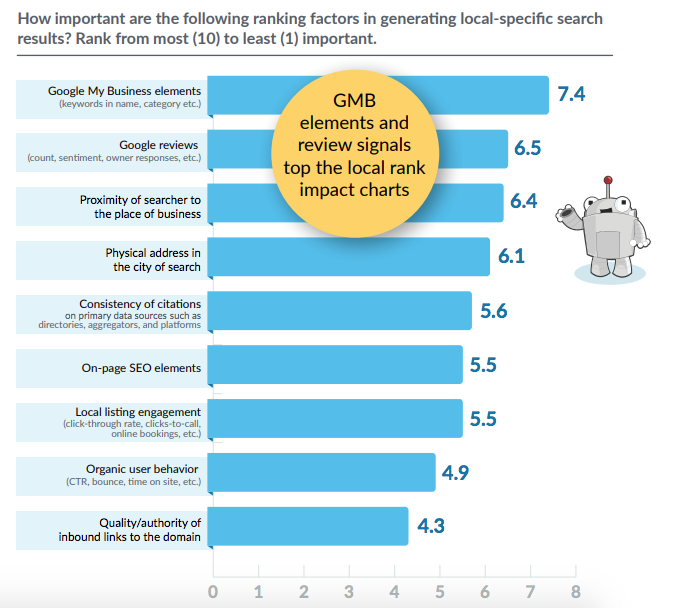
Put a review strategy in place so that you can keep reviews continuously coming in on a steady basis. It should be obvious that you need to acquire Google reviews, however, a good cross-section from other relevant review sites can also have a big impact on your local presence.
How to encourage more reviews
In order to encourage receiving the highest reviews, make sure you only ask people that are extremely satisfied with your work. A personal request goes a long way, however, people don’t always remember when they get home, so you may need a backup plan.
Include the request for a review on the receipt or in a thank you email after you’ve completed any particular service. Embed a link in your email with written instructions to simplify the process and serve as a reminder to your clients.
Respond to positive and negative reviews
If you’ve asked for a review and received one, thank your client. There is a way to do this on every platform and a simple expression of gratitude will go a long way. When other clients see your responses, it can be more encouraging for them to leave a review as well.
Negative reviews are bound to happen. Be sure to respond in a timely manner in order to show your best customer service. Publicly offering to correct a mistake or misunderstanding shows people you’re willing to go the extra mile to make your clients happy.
It also puts another spin on the situation apart from the disgruntled clients. Train your receptionists to include asking clients if they’re happy with the service. Having a system where reviews continually roll in is a great way to strengthen your local presence.
How to choose the best keywords for your practice
In order to drive the highest converting traffic, you’ll need to identify the keywords that suit your practice best. List the main services that you want your practice to be known for to create the major pillars of your site.
Using a keyword tool you can confirm the number of searches and the level of competition that each keyword possesses in order to finalize your decision. Here you can see the keyword root canal is a level 57 difficulty.

If your city us super competitive you may need to add a geo modifier in your title and URL to make your page hyper-local. By adding Toronto as the geo-modifier, this reduces the competition considerably.
Keyword tools can also give you insight into different ways to target the service that you’re offering. There is a list of options that are generated as suggestions to your keyword that you can use as alternatives or incorporate into your content to enhance the optimization of the page.
Choose the keywords that offer the highest volume of traffic with the lowest competition. Whenever you consider pursuing a target phrase always use it a Google search yourself to see what results are displayed. You want to confirm that you’ve assumed the correct search intent that the keyword suggests.
For example, you should expect to see other dentist websites appear in a keyword search you’re considering to target. Anything other than your competition may suggest that the users are not looking to hire a dentist, but gather information or satisfy a different form of search intent.
Implement a content strategy that builds awareness and educates
A major part of driving traffic to your website is publishing content that is popularly being searched. SEO for dentists is not just about being found for one keyword, but also involves creating awareness and nurturing leads to build trust and confidence in your practice.
For example, someone who is nervous about getting a cavity filled may be searching Google for answers to questions they have about the experience. Creating a blog that answers these questions increases the number of visitors on your site.
This approach to answering commonly asked questions not only goes a long way with potential clients but is also rewarded by search engines. Using a topical content structure to build on the depth of your services is a powerful way to drive more traffic from Google.
For every service you have, there are different stages people go through before committing to a dentist. These stages can be categorized as awareness, consideration and decision.
Some people may not know why they’re feeling pain when they bite into a pineapple. Your blog can address the potential causes of tooth sensitivity, cavities and provide the options for a solution.
For many new patients, the information provided on your blog is the help they needed to overcome something minor. When something becomes more serious, they are now thinking of your website as a source for dental services from the awareness previously built.
Educating your clients is a crucial part of the SEO cycle that drives more traffic by creating awareness, educating and building trust in your dental practice.
Publish location pages to expand your business
Location pages create a local presence in neighbouring towns and cities. For instance, if you’re in Toronto but would like your practice to appear in Mississauga, a Mississauga location page would be a solution to appear in search results specifically for that city.
Location pages allow your business to expand beyond the limits of your own city. Localized search results are largely influenced by on-page optimization and a local backlink profile.
Although you may not show up in the local pack without a physical address, an optimized location page can get your website to appear in the organic results in any city you target.
Publish local content
Use your blog to publish city-specific content as it relates to your business. Creating content about your city creates strong ties to your locality and will contribute to local rankings.
An example could be keeping updates on the various stages of recovery your city is experiencing that has resulted from COVID-19. Relating this to your business operations and how it affects the residents of your city contributes to positive local optimization signals.
On-page optimization
Every page on your website should target a specific keyword. In order to give your page the best chance at appearing for your keyword, you should ensure it is placed in all the right places. Use a plugin such as Yoast to make things easier by alerting you if any of the major on-page optimization attributes are missing.
Here are a few of the main aspects of on-page optimization:
Use a keyword-optimized title with H1 tags
Your H1 tag should contain your keyword because it describes to search engines the most important content on the page. Most content management systems will tag the title of your page with h1 tags automatically.
Your title is one of the most important parts of your page because it’s what appears in search results. Be sure to include your keyword in the front end of your title to ensure it’s not cut off or truncated on smaller sized screens.
Write a compelling meta description
Your meta description is another crucial part of advertising your page in the search results. The description you use should create an interest in clicking through to your page.
Write your meta descriptions using keyword-rich descriptions. The use of keywords communicates to the user that they have found what they’re looking for and promotes a higher click-through rate.
Again, keep your target keyword near the front end of your description.
Use your keyword a few times within your content
In order to show that your page is highly related to your target keyword, it should appear in your copy at least a few times. There’s no need to repeat your keyword more times than that since it won’t make your page any more optimized. In fact, unnatural use of your keyword or excessive repetition may result in adverse results to your search visibility.
Use your keyword in the first 100 words or first paragraph whenever possible.
Optimize your images
Save your images using your keyword in the filename. If you have multiple images, don’t overdo it, simply use keyword synonyms.
The alternative description (or alt tags) tell search engines and the visually impaired what your image is about. Use your keyword and keyword variations with the alt tags of images you post. In this example of an image in WordPress, you can see the keyword improve on-page SEO highlighted in the area assigned for the alt tag.
Use the correct dimensions for the images you post. If you have images that are 2000+ pixels, the chances are you won’t need an image that large. Reduce the file size to exactly what is required on your site will increase your page speed from reduced server requests and a smaller file.
If you’re using WordPress, install a plugin called Smush to compress your images. You can also implement “lazy loading” which delays images beneath the fold from loading until you scroll down towards them resulting in faster page speed.
Interlink your content
Using internal links can enhance the optimization of every page on your site. When you have a page that references the content on another page, you can use an anchor text link to connect the pages.
The text you use to link the pages should be descriptive in order to increase a search engine’s understanding of the content on your page. Use both optimized and un-optimized anchor text to interlink content on your website.
Building authority, credibility and ultimately ranking ability
If you’re no stranger to SEO for dentists, you might already understand the significance of building backlinks to your website. In order to build authority and credibility, your website needs “referrals” or “votes of confidence” from other websites. These come in the form of backlinks.
The main concept that ties ranking in with a strong backlink profile is that other websites find your content so valuable that it’s worth sharing with a link.
In order to get the most from your backlinks, you need to focus on getting links that improve your credibility in your expertise, and in your locality. Acquiring backlinks from local sites in or related to your industry are considered the most powerful types of links.
Leverage the power of unstructured citations
An unstructured citation is an instance of your name, address or phone number being posted to another website-even though there is no set place for it to be listed.
For example, a directory listing is a structured citation because there are specific places to enter your information. A blog post that mentions the name of your practice is unstructured because the name of your company is used contextually within the content of a page.
List your professional resources for unstructured citations
Write a list of twenty people that you know have websites and are related to the dental industry. Ask the following questions:
- Who do you order supplies from?
- What companies do you work with?
- What other dentists may support you with a link from their website?
Exhaust your network for likely candidates because the people who already know you are most likely to link to your site.
Search Google or link opportunities
Another method of identifying links is to search Google using specific command operatives such as inurl.
You can look for sites that offer resource links and guest posting opportunities by telling Google to search for websites with a keyword in their URL.
For example, the command teeth whitening + inurl:links displays the following websites with pages that link out to other websites:
Join a professional association
You can also become a member of professional associations. These sites will often link back to your site with a highly relevant backlink. Here’s an example of a profile from the Dental Industry Association Of Canada:
One practice that requires a bit of caution but is highly effective, is spying on your competitor’s backlink profiles. Enter the URL of a top-ranking website into an analytic tool like Moz to get a glimpse at the websites that are linking to the top websites ranking for your keywords.
Keep in mind that although you may find a lot of backlinks that point to a top URL, not all of them will be good for your site. In fact, some of those links may not be good for your competition either.
Make your decision based on relevance to your niche, city and whether the site gets a decent volume of traffic. You don’t want to go through the effort of getting a link on a graveyard site because Google won’t give you too much credit for those anyway.
Tracking and monitoring your progress
In order to adapt and grow, create measurable goals for your website. This cannot be achieved without tracking the performance of your website on a monthly basis. Two of the most powerful tools you’ll need also happen to be free of cost.
Make use of webmaster tools using Google search console
Just as you would open the hood of your car to see the engine, you open Google search console to see what’s going on with your website. Search console tracks the performance of your site as well as alerts you to any problems that it may be experiencing.
Familiarize yourself with the performance tab functions to see what pages are ranking. You can see your top-performing pages, how many times they appeared in searches and how many clicks they received.
You can also monitor any errors that are being generated from your site that might affect page ranking.
Google analytics
Although Google search console can show you a lot of information, you need Google Analytics for more specific details in reporting. Here you can customize reports, set goals and monitor goal conversions.
An example of a goal conversion could be to get visitors to make a call or book an appointment. You can set this up in Analytics by going to Admin, Goals, New Goal.
You can also see how your users are navigating your site.
There are also comparative reports you can run to see whether your website is generating more traffic at any given block of time. You can compare previous years, previous months or any specific periods of time.
Tracking results is your only way of knowing whether your SEO efforts are paying off. Despite the advanced capabilities of Search Console and Analytics, if you’re interested in tracking your website’s rankings, you’ll need a separate rank tracking software such as Moz, Ahrefs, SEMRush, Rank Tracker, etc.
Capitalize on Local SEO for dentists and increase your revenue
Defining a local SEO strategy for your dental practice is one of the wisest decisions you can make for our business. SEO is one of the few marketing strategies that is growing in popularity and will only get more competitive as time passes.
Take control of your companies growth by implementing the practices outlined in our guide. Build a local presence for your dental practice to guarantee the long-lasting success and growth of your business.
Will Toronto’s Stage 3 Delay Help Or Hurt Your Business?
Toronto- On July 25, 2020, Premier Doug Ford Toronto’s stage 3 delay due to the fact that public health officials requested more time to analyze data. This has officially delayed Toronto’s move to Stage 3 of the COVID-19 reopening plan Ontario has laid out for most of the province.
Windsor and Peele join Toronto’s Stage 3 delay in the plan for the gradual and safe reopening of in-person businesses. This may damper the outlook on the immediate economic recovery but this doesn’t change what Toronto companies should be doing now to promote the growth of their business.
Capitalize on the growing demand for online transactions
If there is one key takeaway from this unprecedented experience, it’s that contactless service is now a valuable asset to have in your business.
Companies need the ability to offer goods and services online and promote contactless operational methods. Precautions need to be made to reduce the transmission of deadly diseases that rear their ugly head now and in the future.
For brick and mortar business that may mean shifting as many products as your company offers online. Companies that were able to adjust and adapt to the quarantine restrictions were also able to realize above average results in sales.
Companies that couldn’t find the right solution have suffered, and many have closed their doors permanently.
Adapt to accelerating trends
The future of the way we do business was already trending towards an increasingly digital environment. E-commerce has been on the rise and the importance of search engine optimization in periods of quarantine has increased profits for niche retailers such as Wayfair.
Wayfair reported increased profits of over 40% during the pandemic. Prior to quarantine, this retailer was struggling to turn a profit.
Wayfair’s results are a testament to the rapidly changing behavioural patterns that consumers have demonstrated amidst the crisis. More people are more willing to seek and use online solutions.
Local SEO has taken on a new level of importance as more customers find local Toronto companies through their cell phones, voice search or a Google search. In order to maximize revenue, there needs to be a local search presence for keywords that are vital to your business.
Consult with an SEO company
For most businesses now is the best time to invest in SEO services in Toronto. Unless you truly believe that the world is ending, then you have to accept that there will be an economic recovery.
The best time to get in on a stock is before the climb upwards. Investing in your website’s SEO now will give your business a huge competitive advantage six to nine months down the line when demand starts to accelerate.
Give your Toronto business a headstart
SEO takes time for a website to experience the full effects of traffic generation and lead conversions. Now would be the time to improve the search visibility of your company. Position your website to receive as many visitors as possible when the economy starts to move.
Regardless of the recovery get your website moving in the right direction by developing it to generate more leads and new clients. A number of industries have already experienced a surge in traffic from increased online searches.
Many retailers are struggling to keep up with the demand.
If this isn’t the story for your company, make it your story by speaking with an SEO consultant and learn how we can help your business increase revenue. Use Toronto’s stage 3 delay in reopening to your advantage by capitalizing on increased online demand.

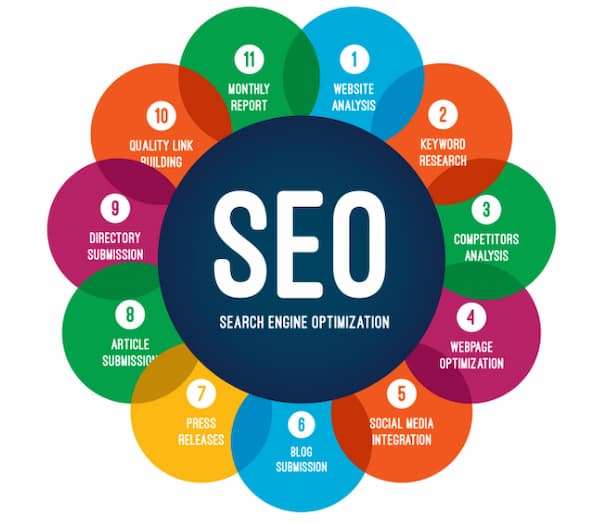
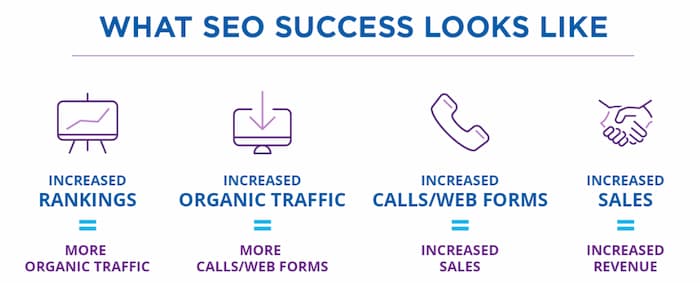
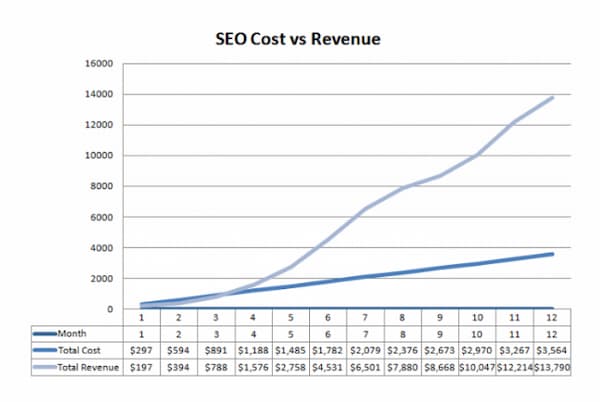
![Local SEO For Small Businesses [2020 Update]](https://digitalducats.com/wp-content/uploads/2020/10/Google-my-business-storefront.png)



